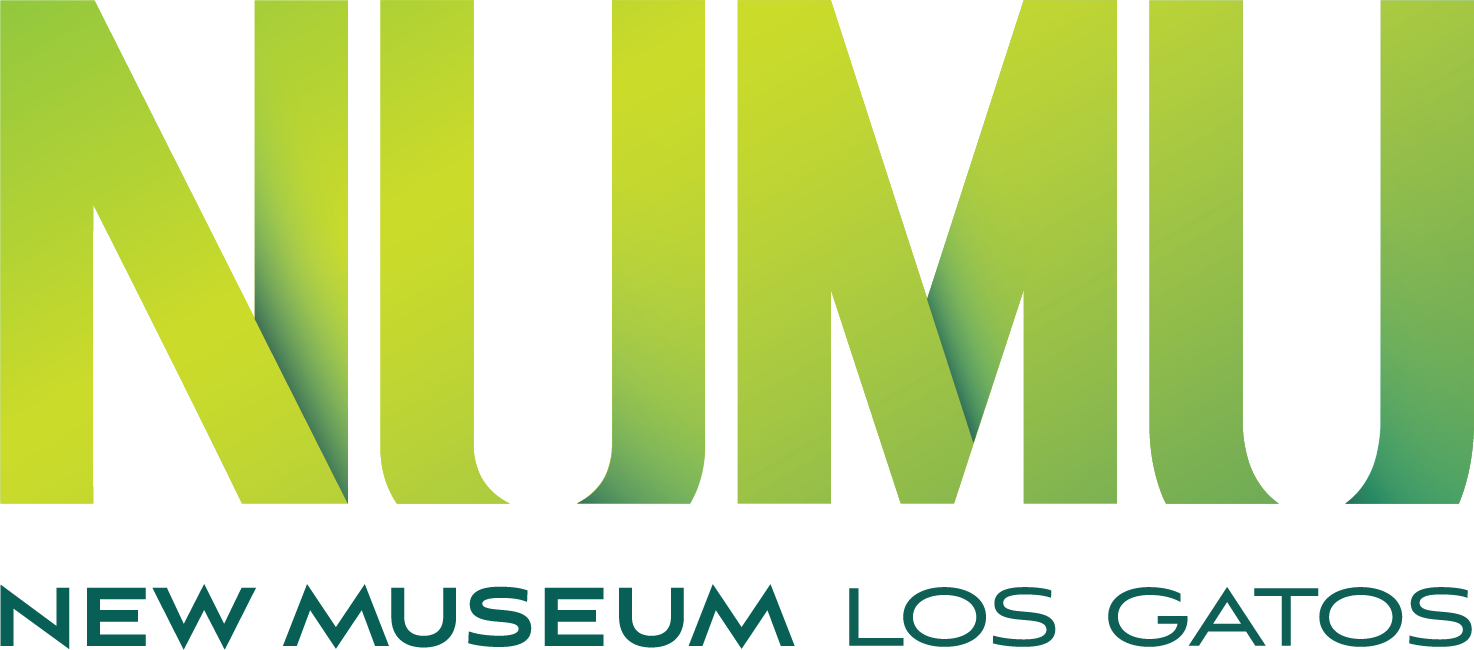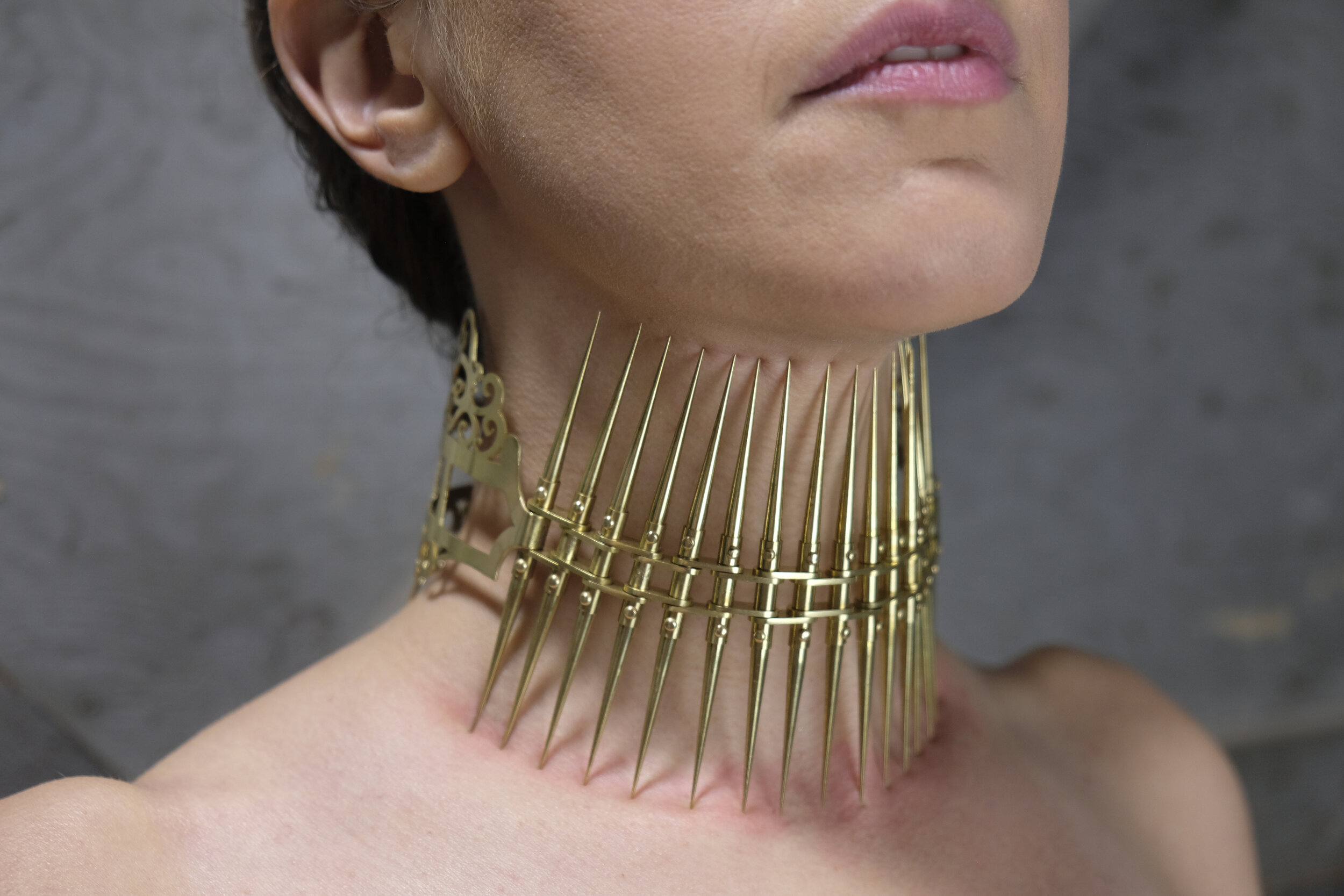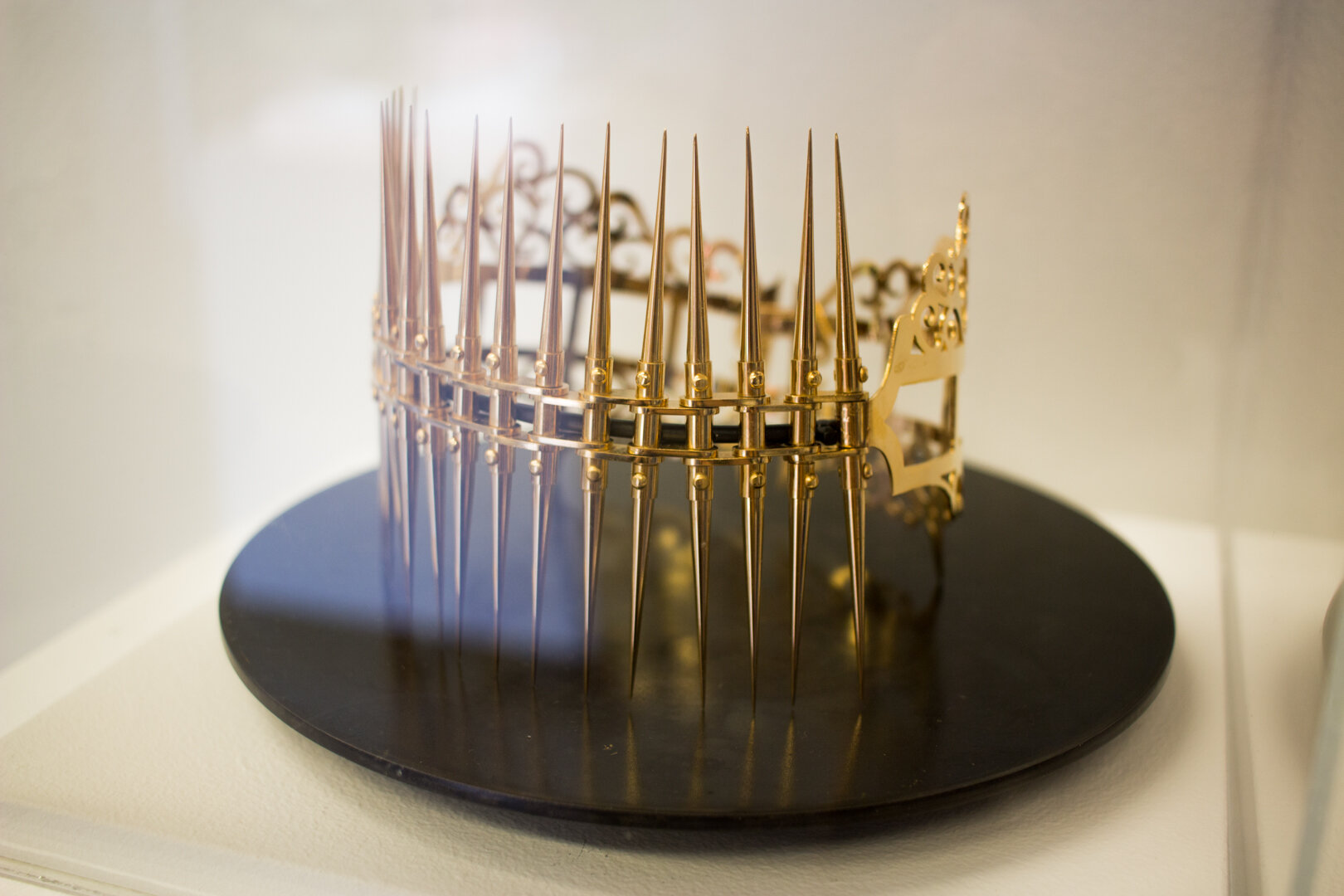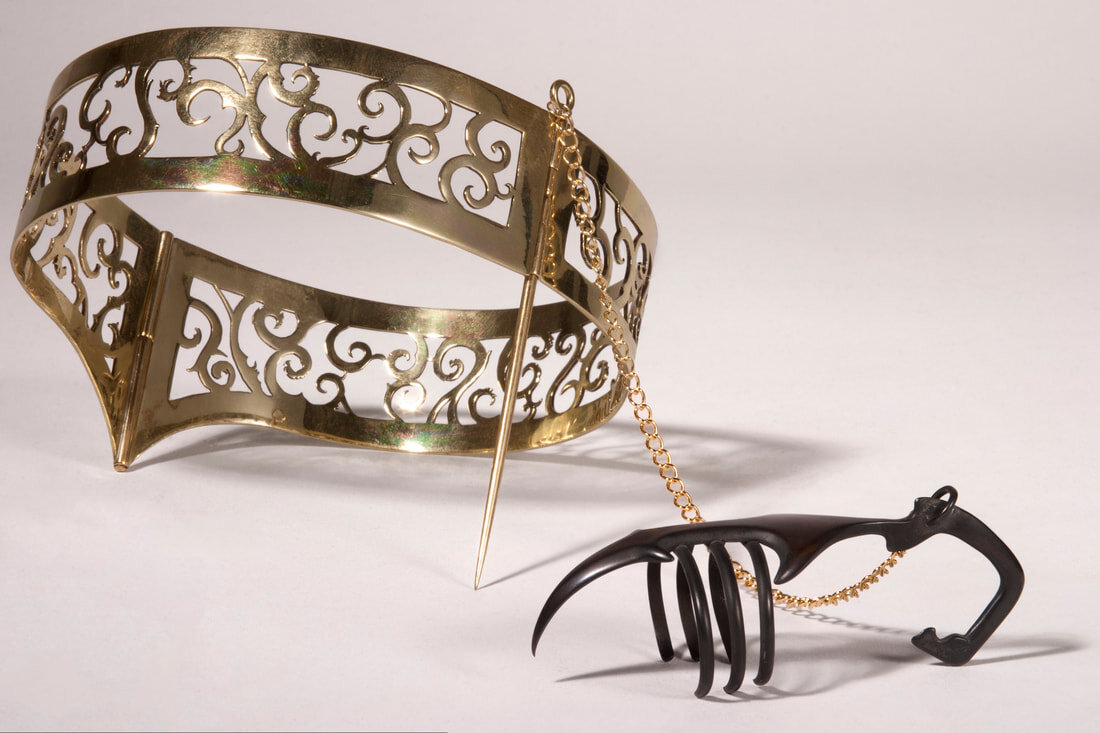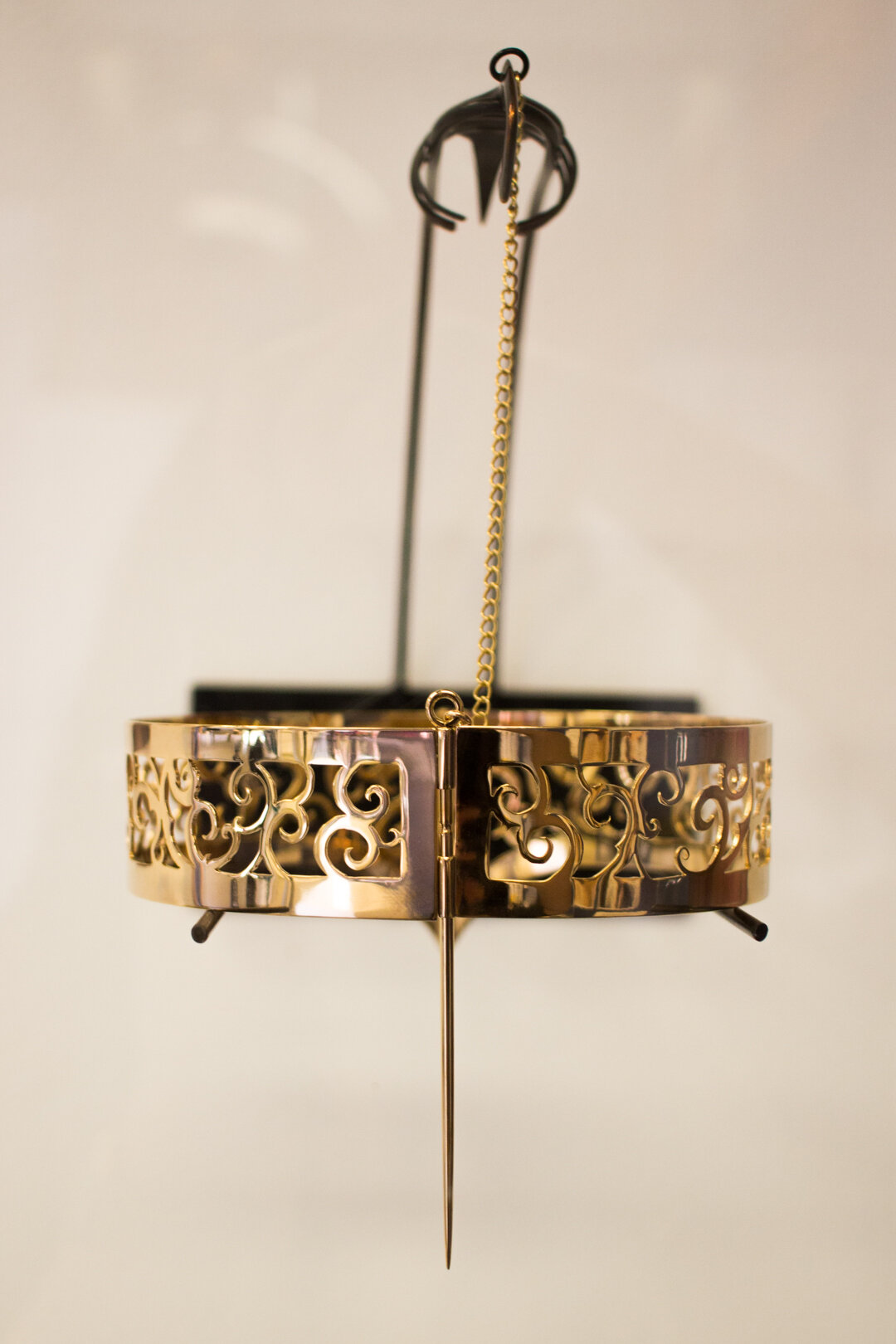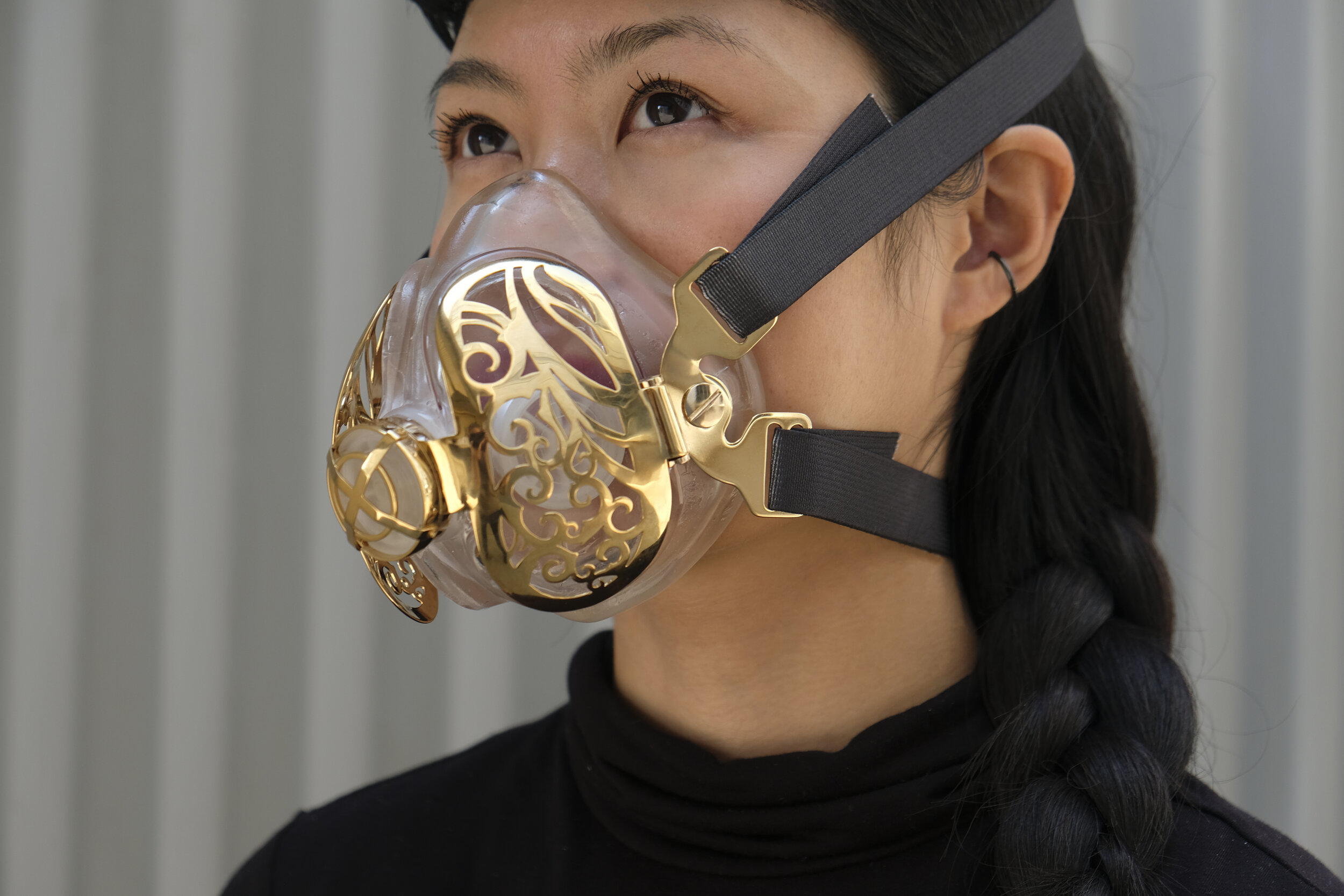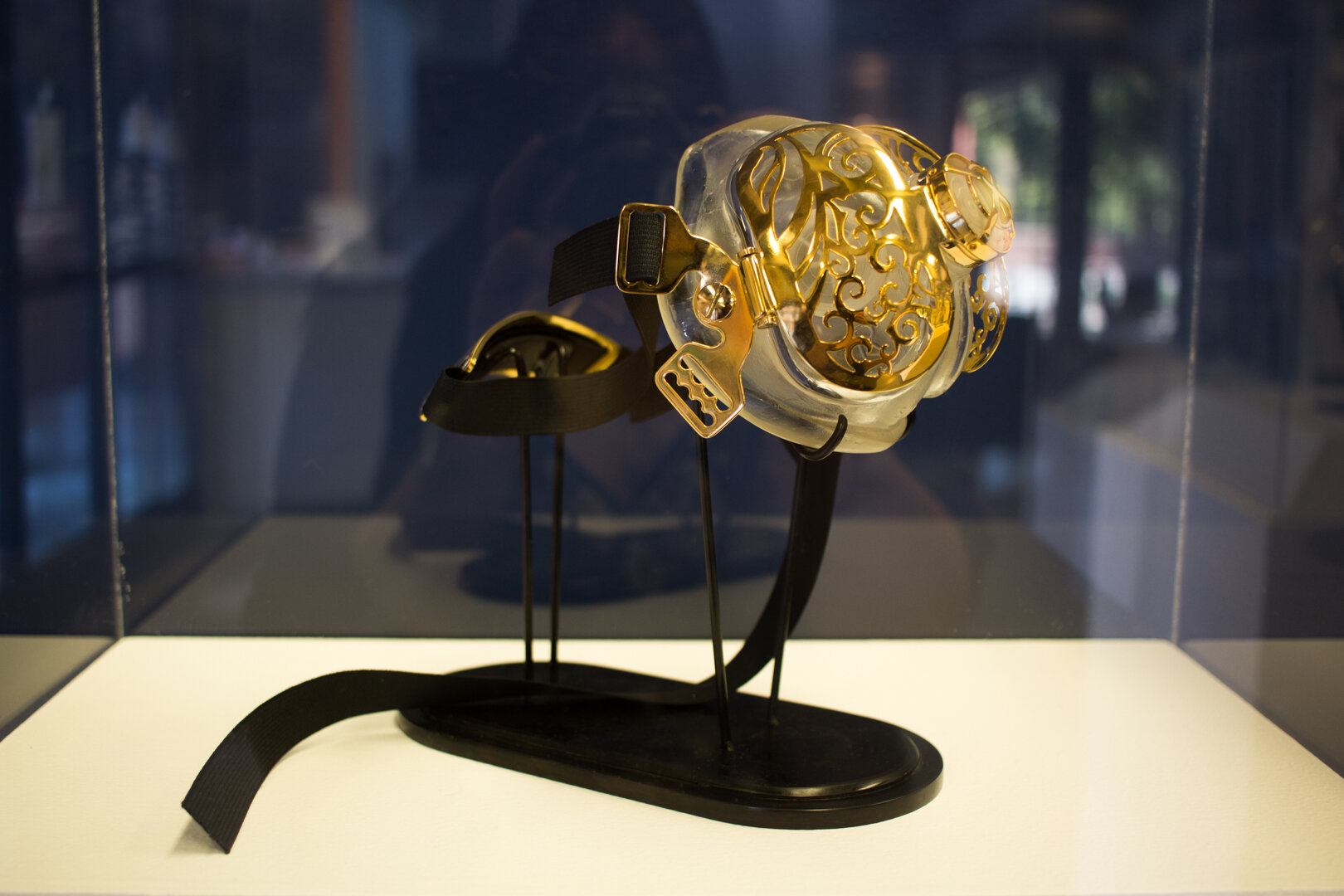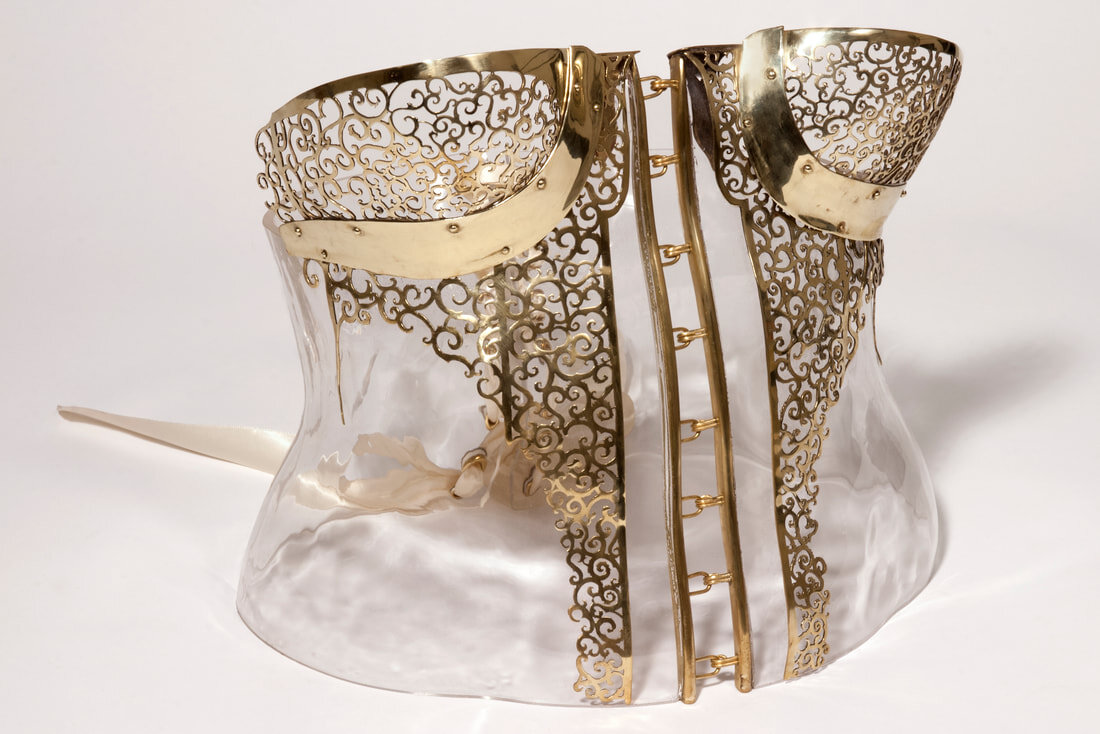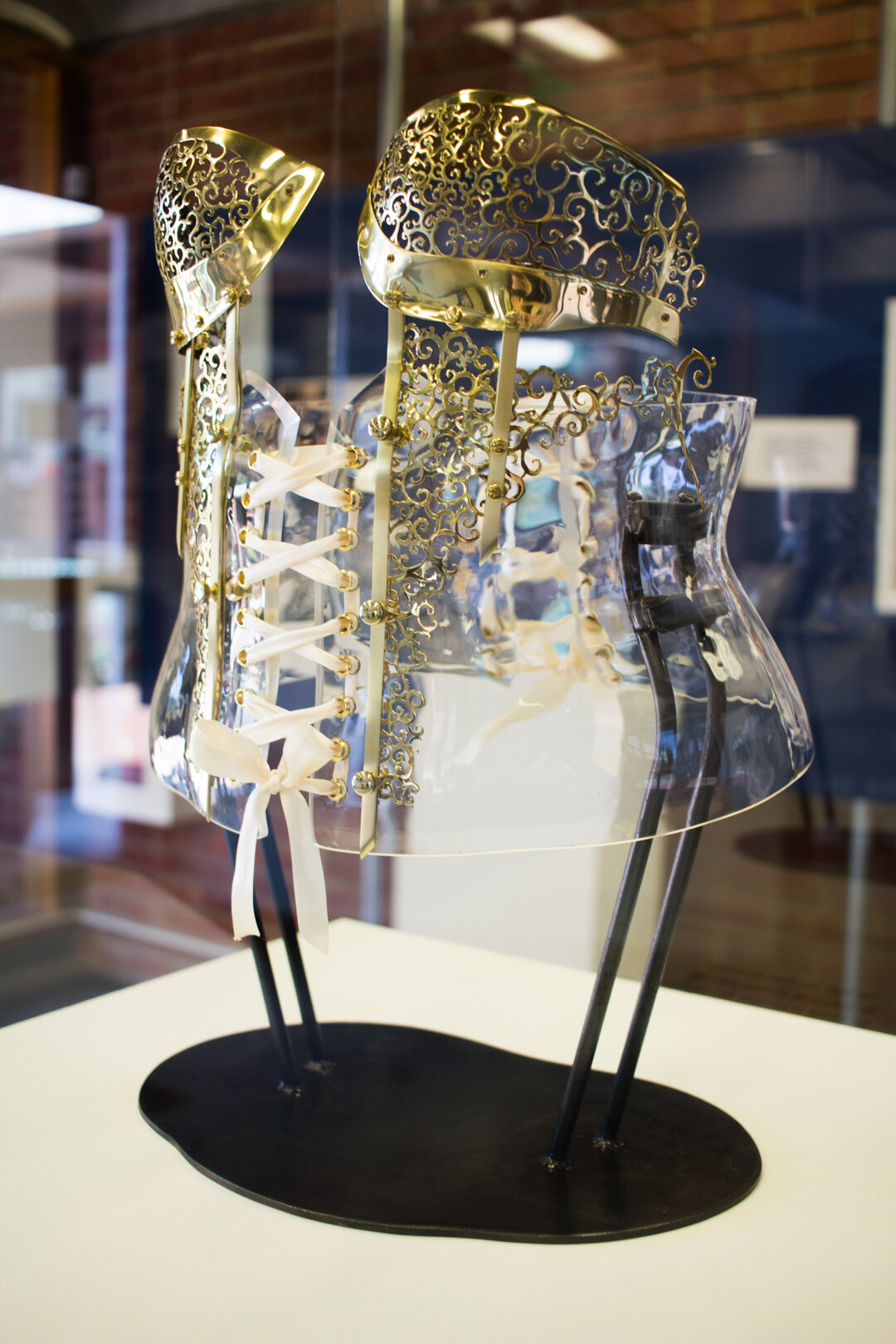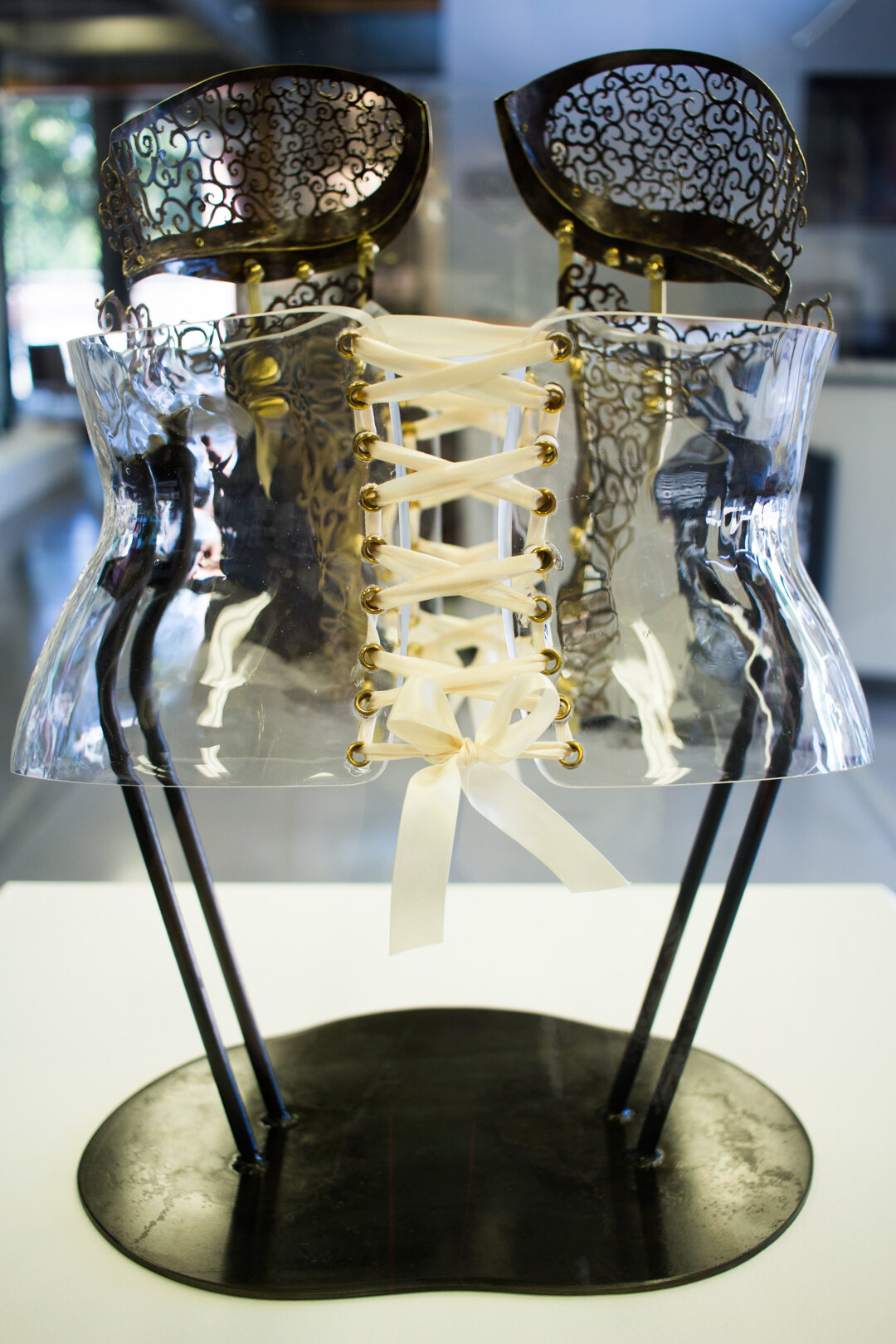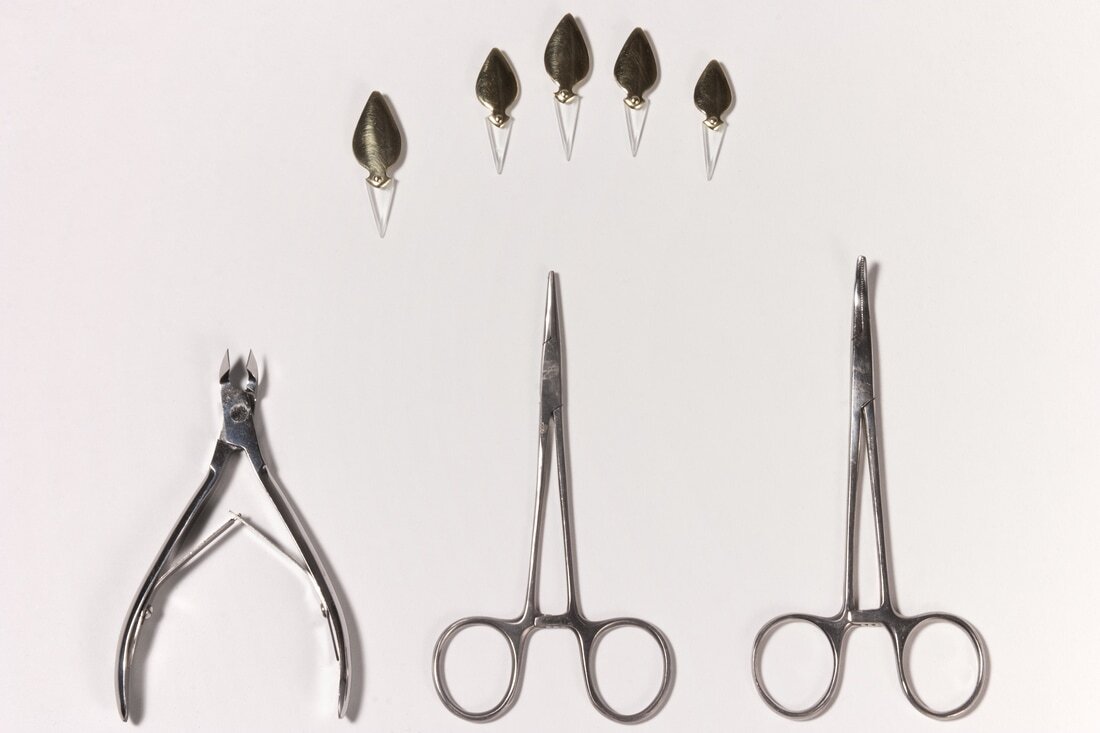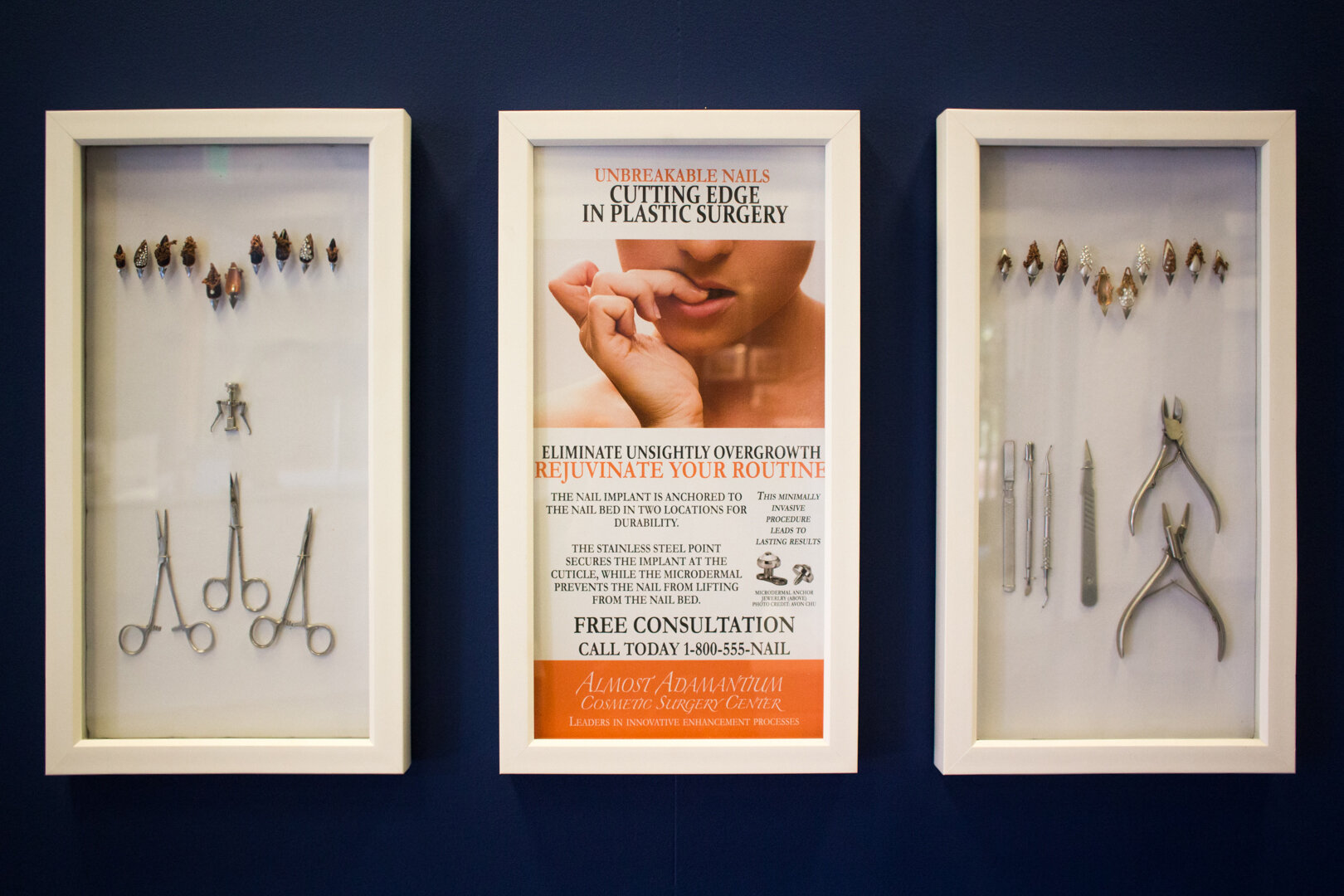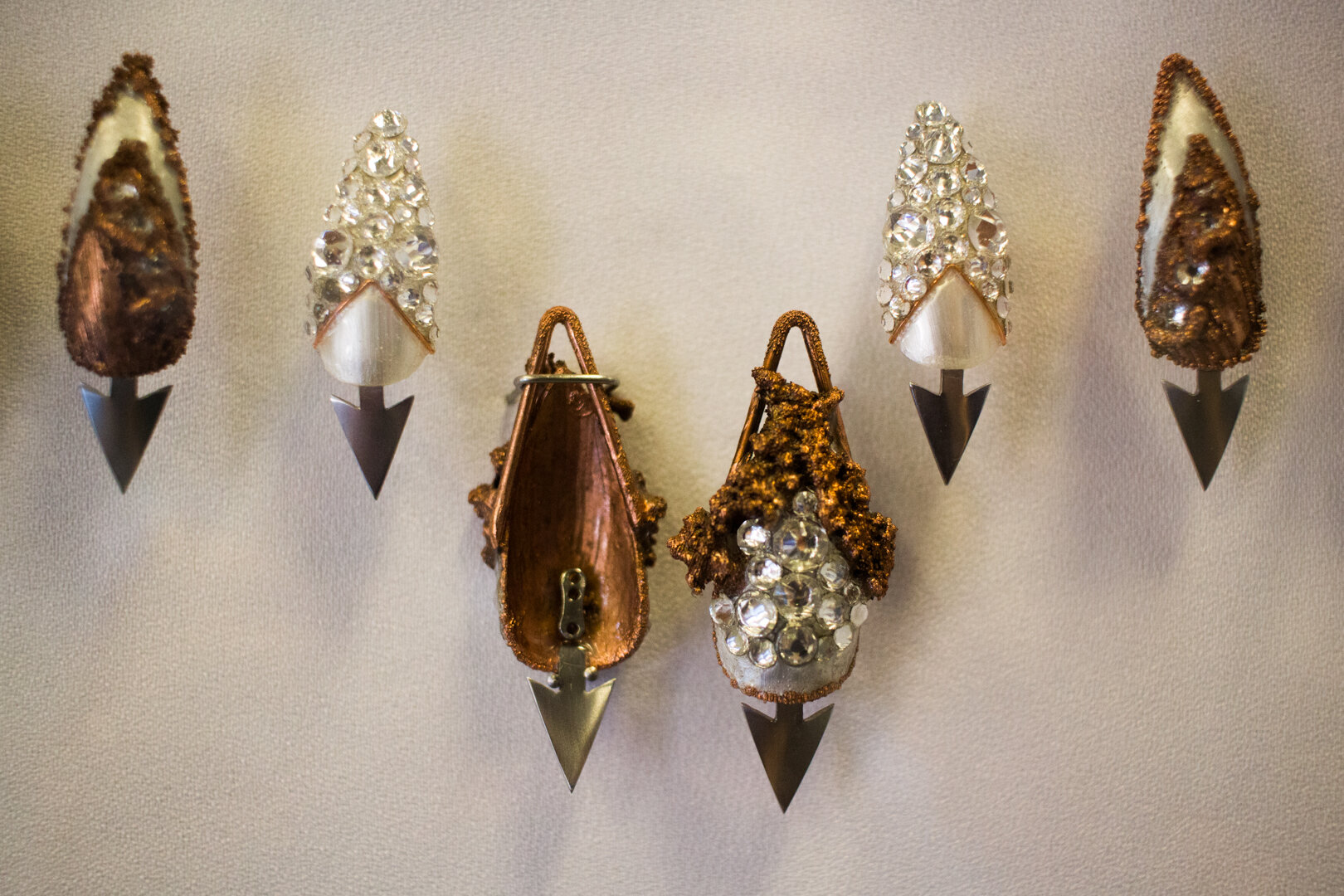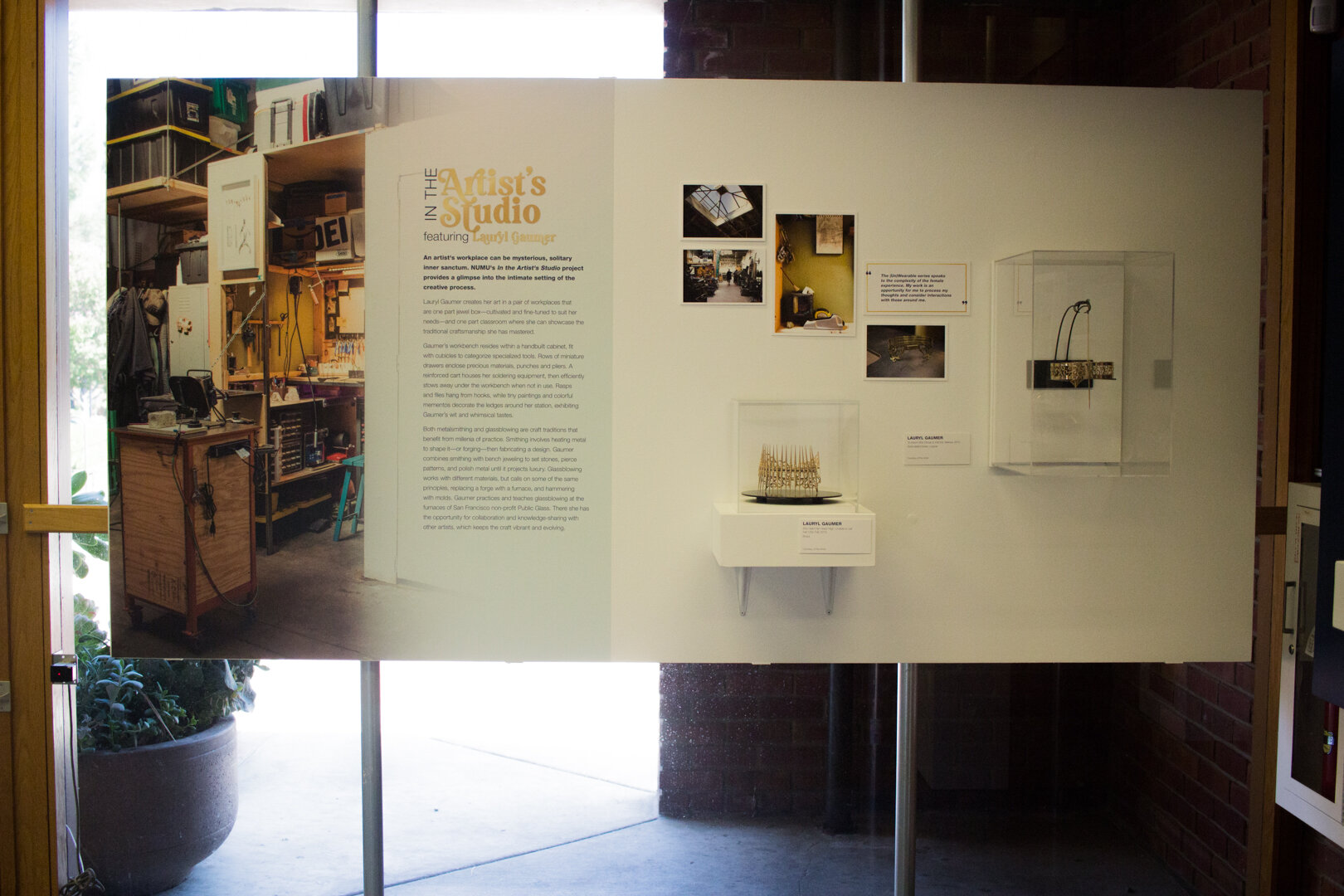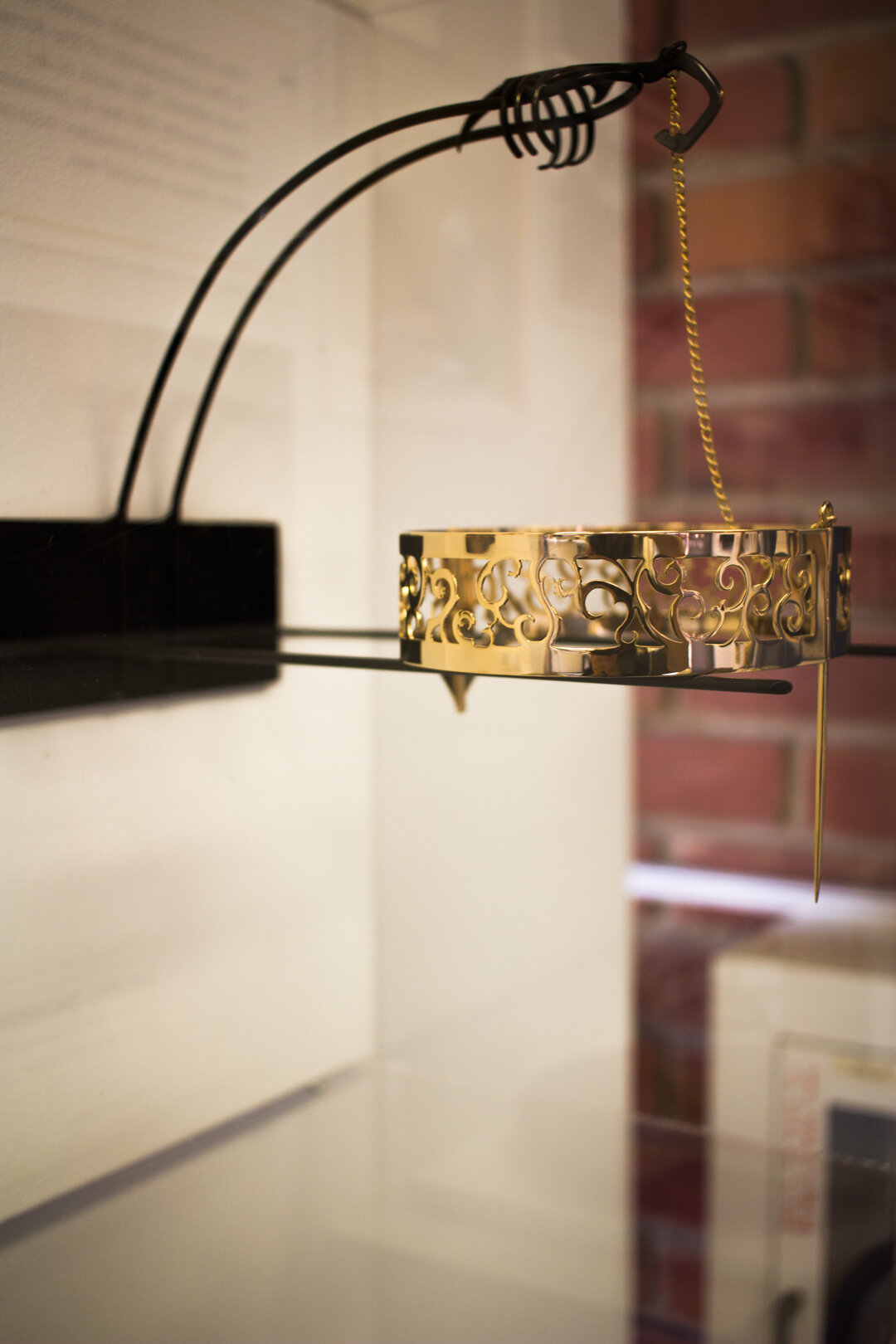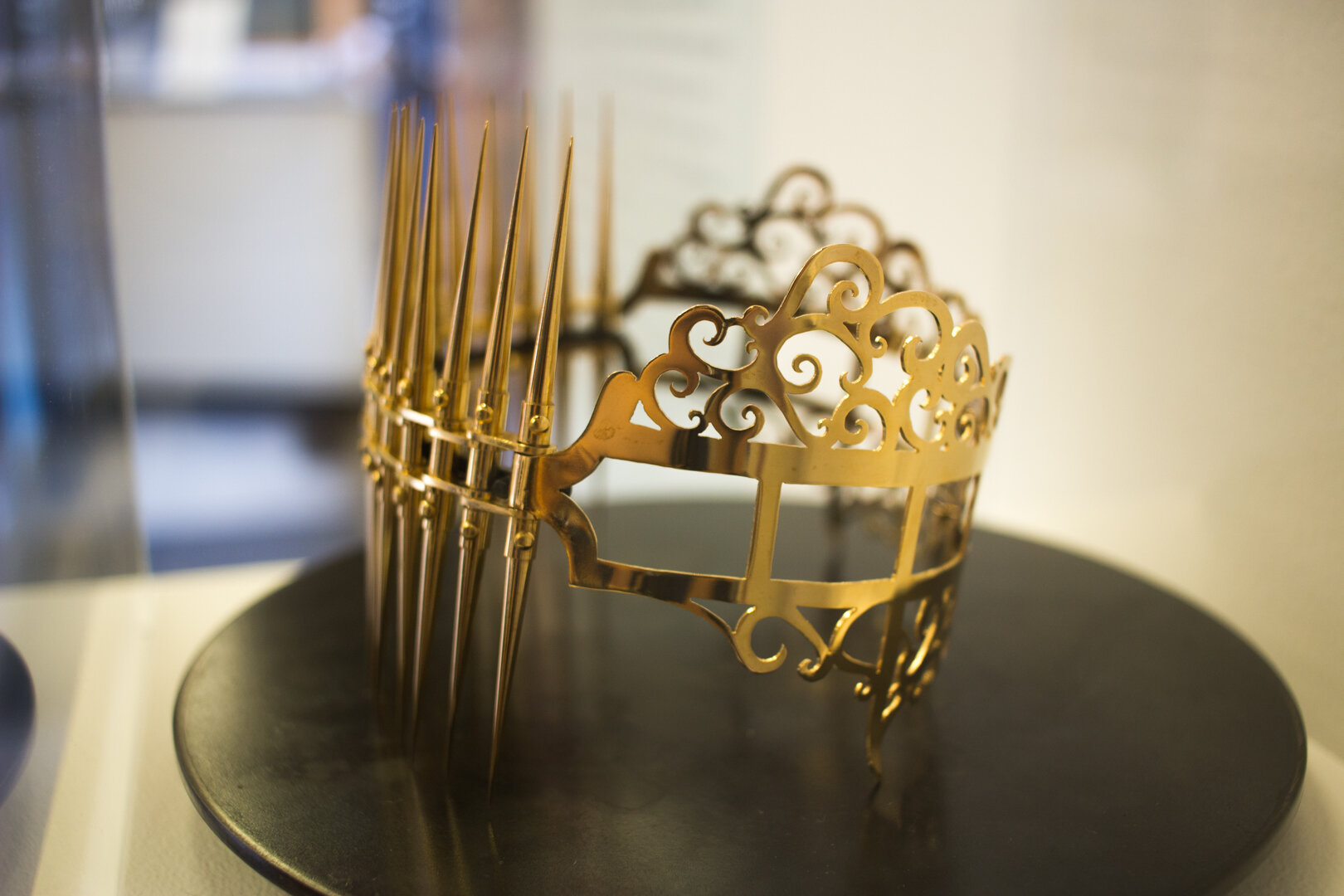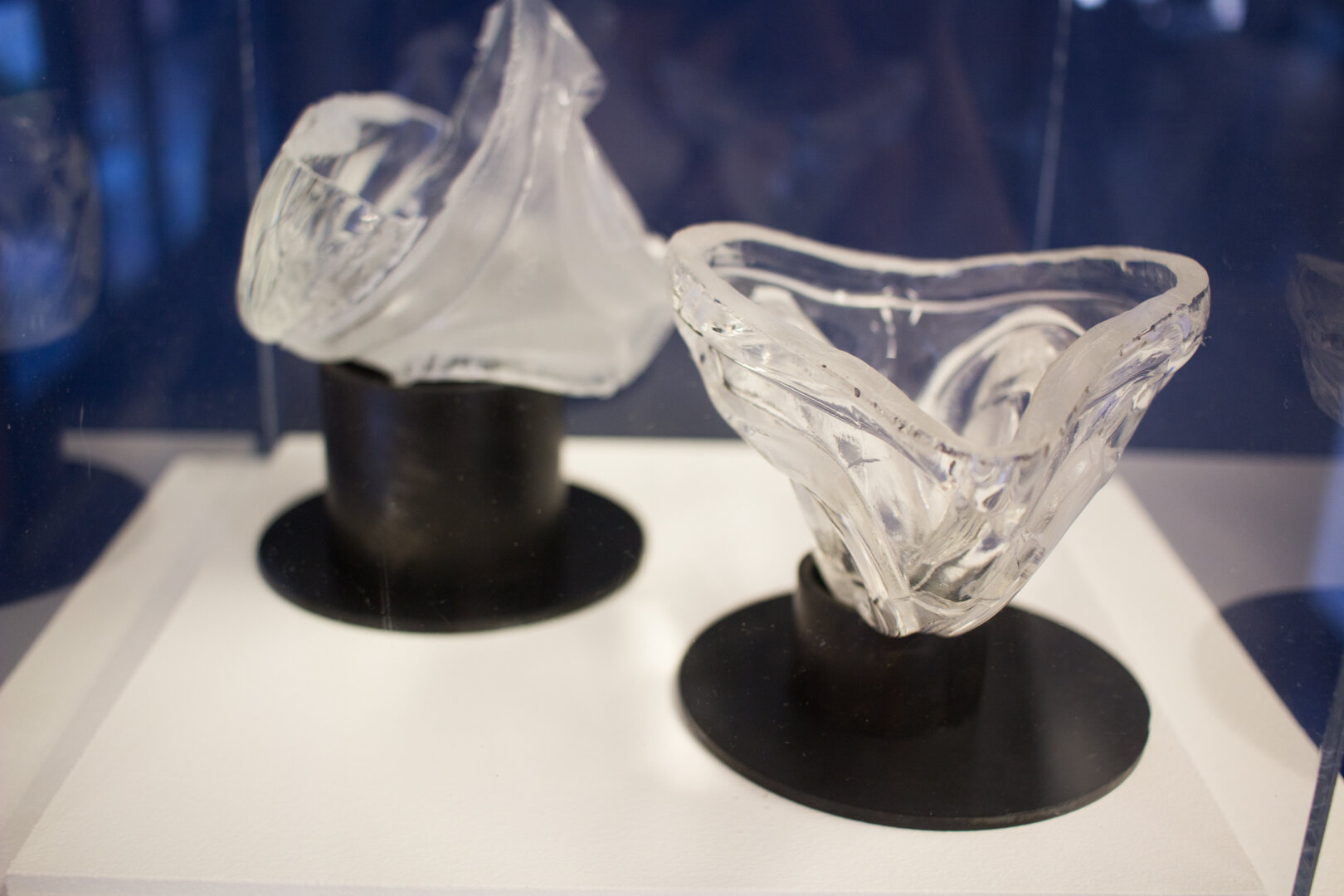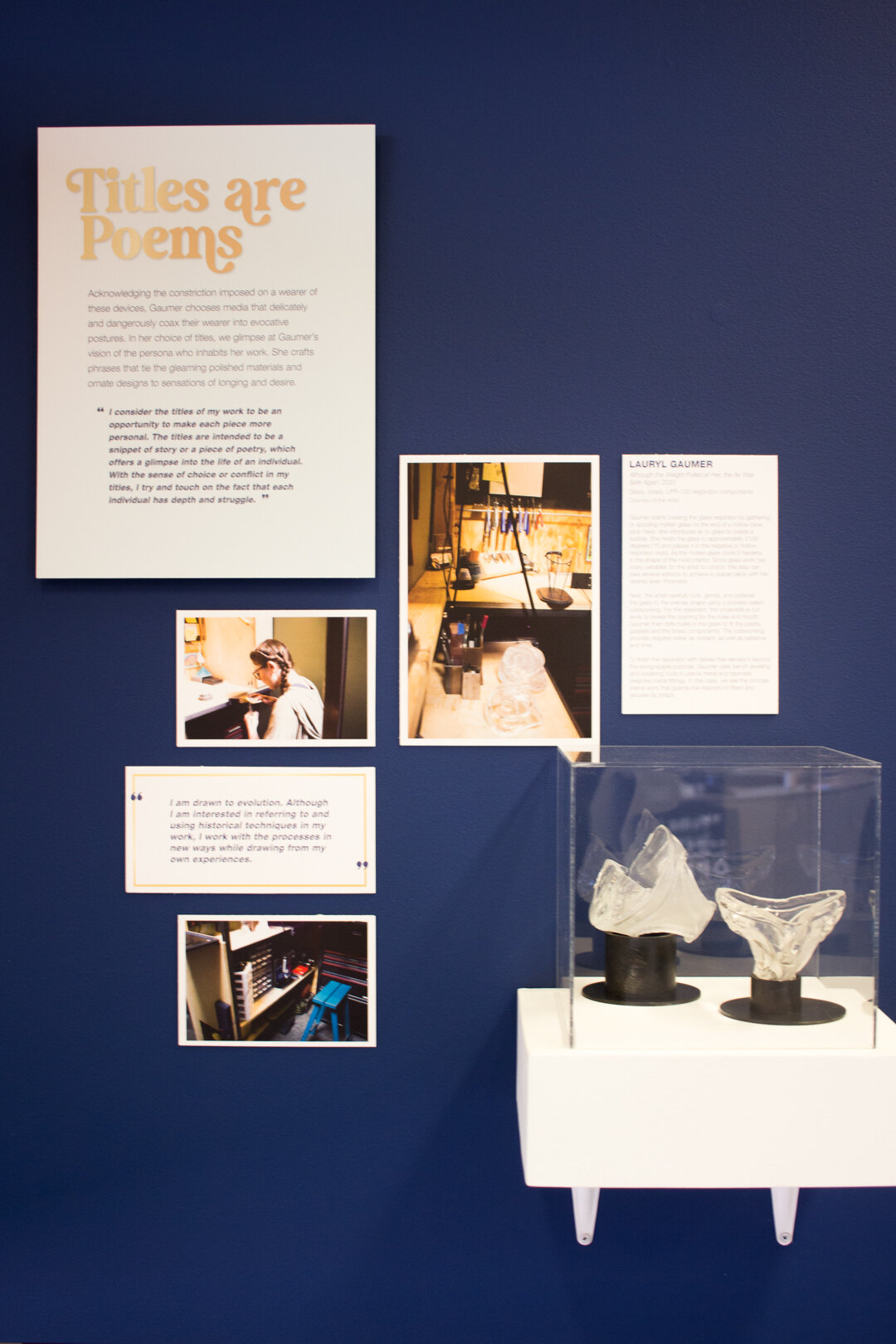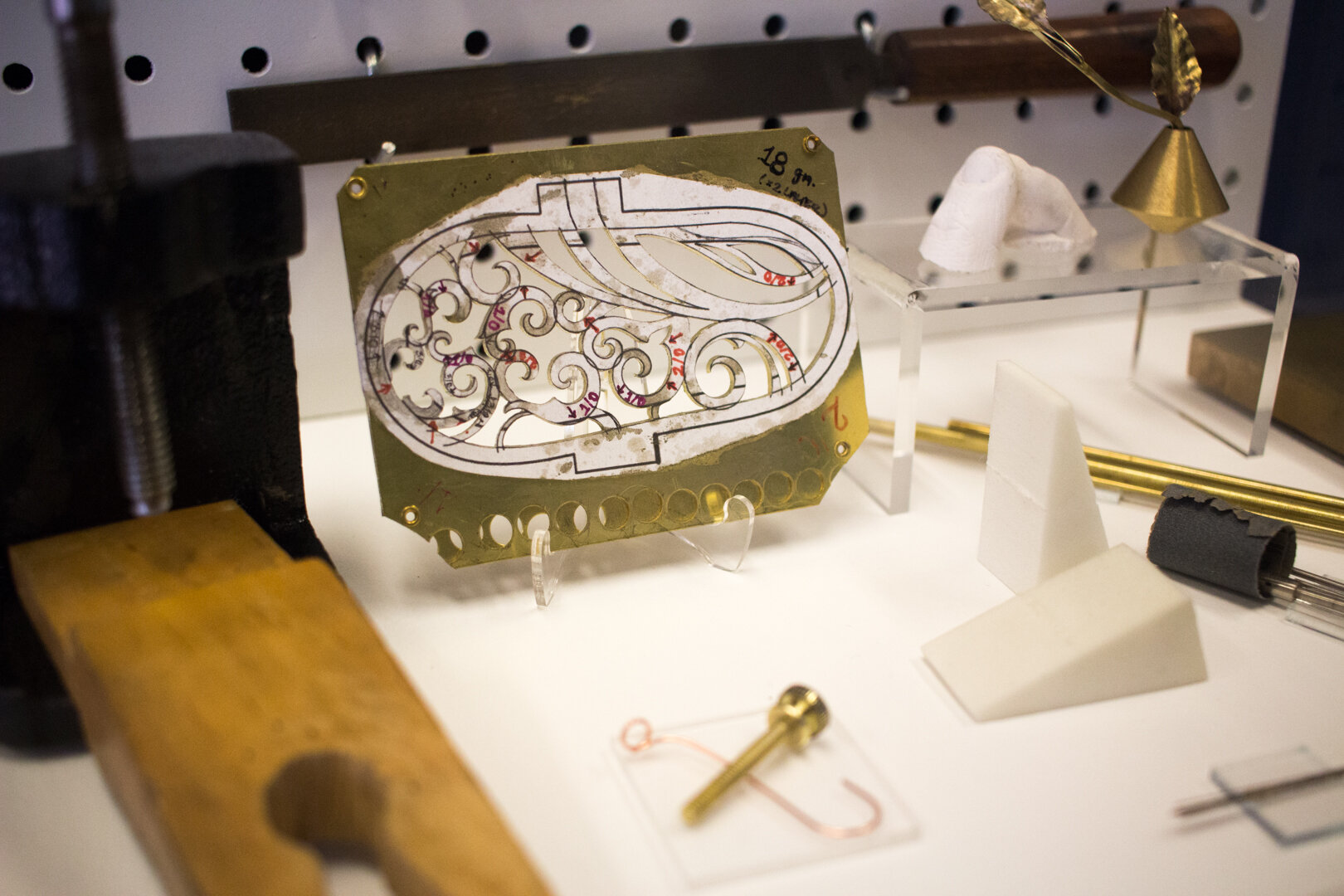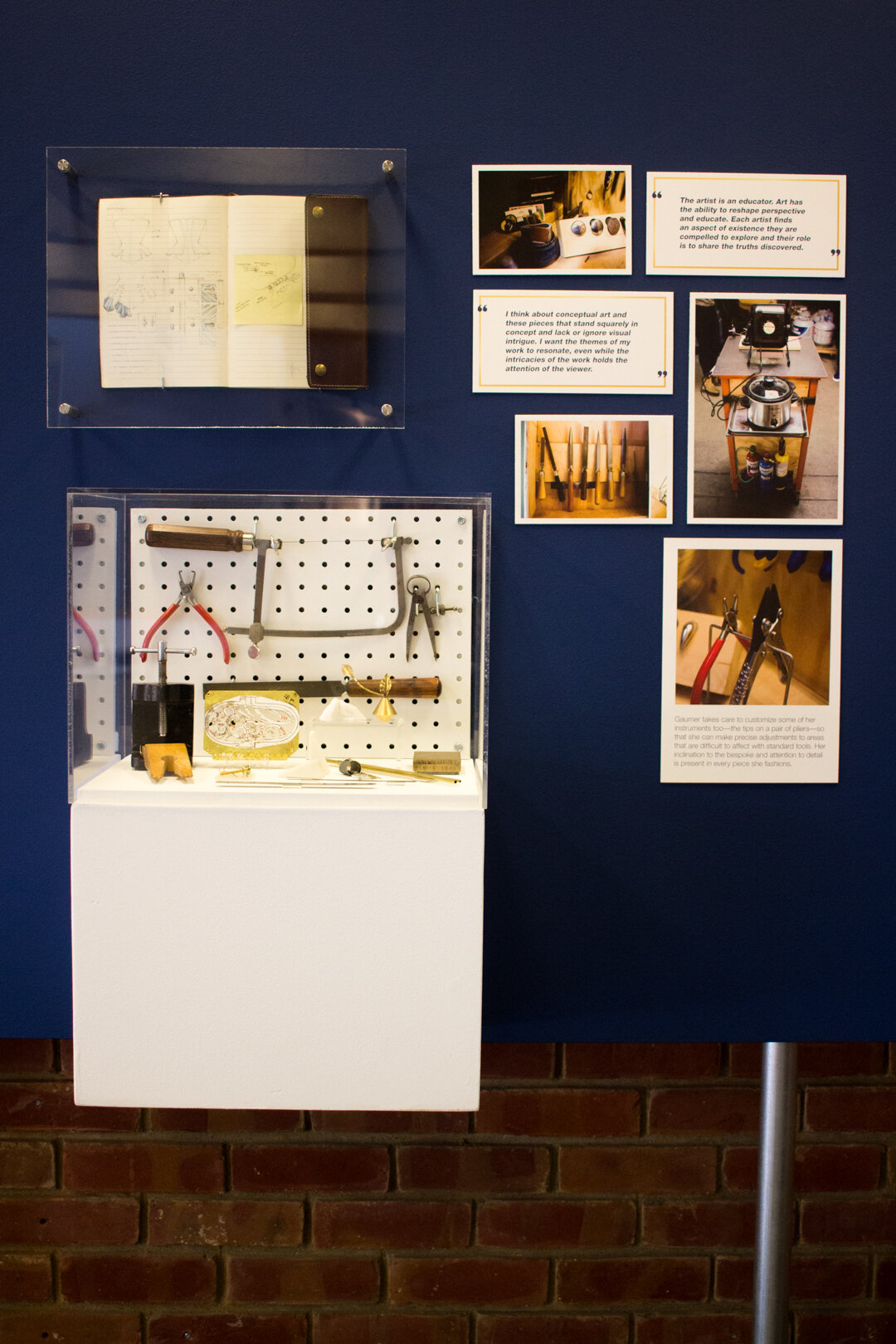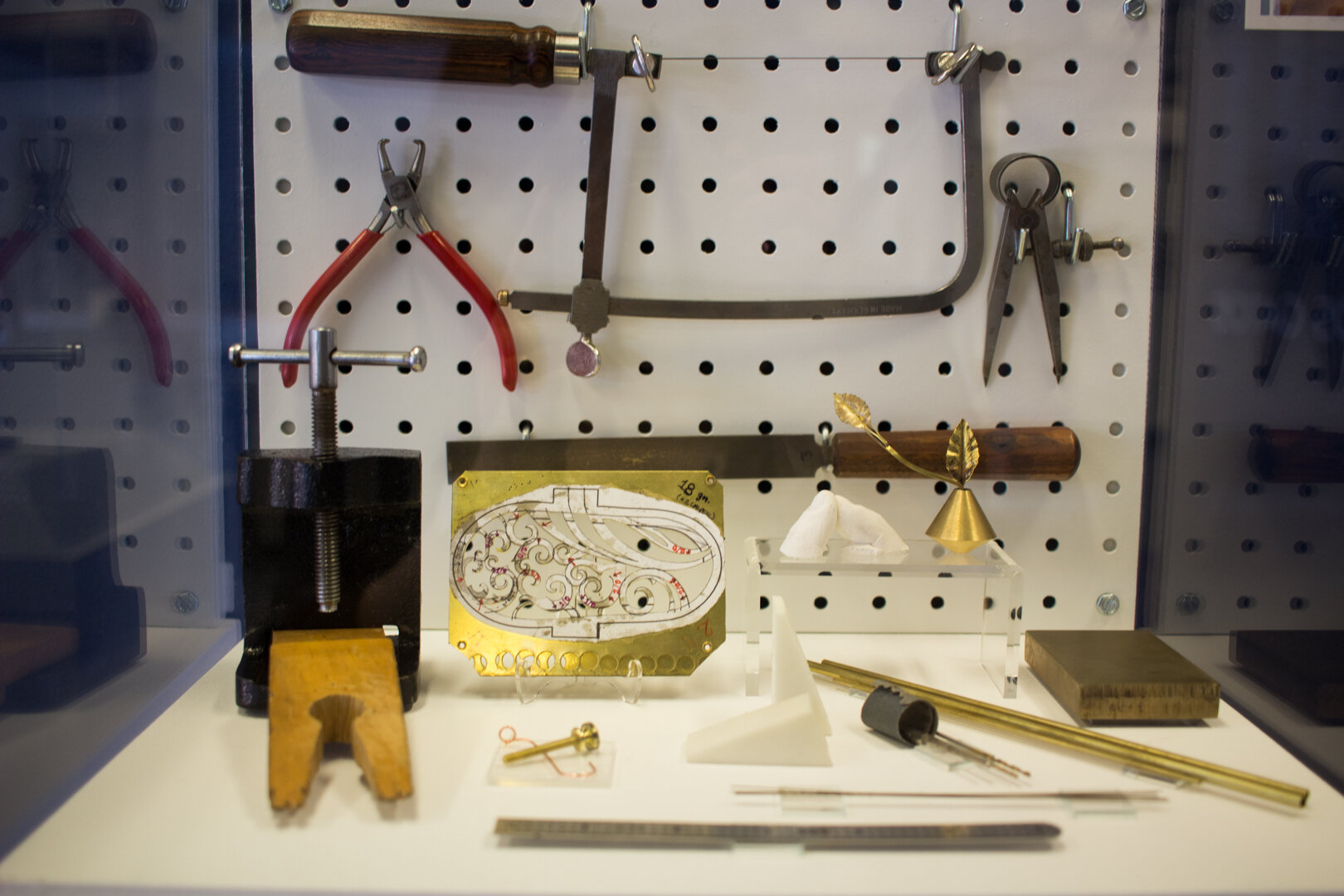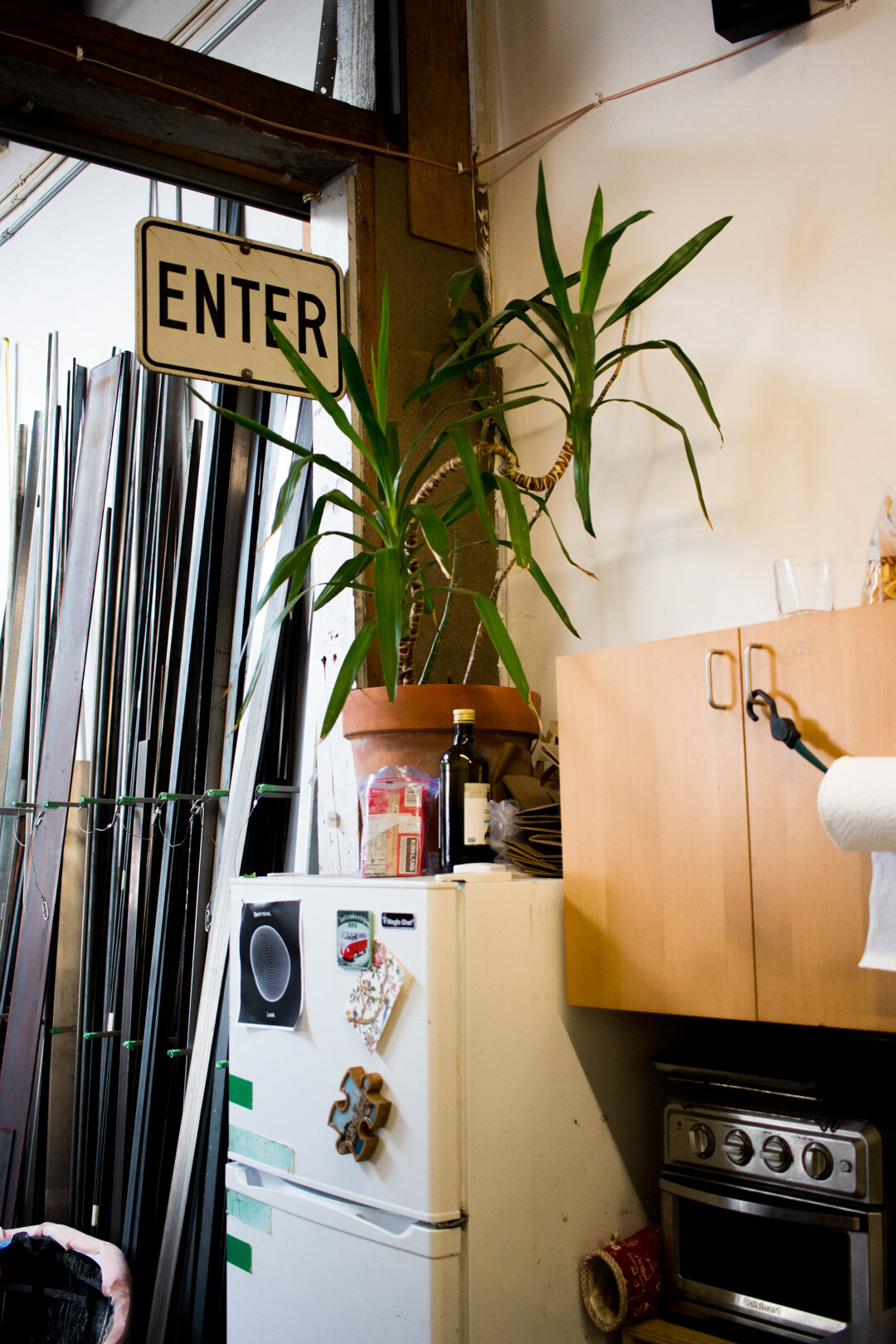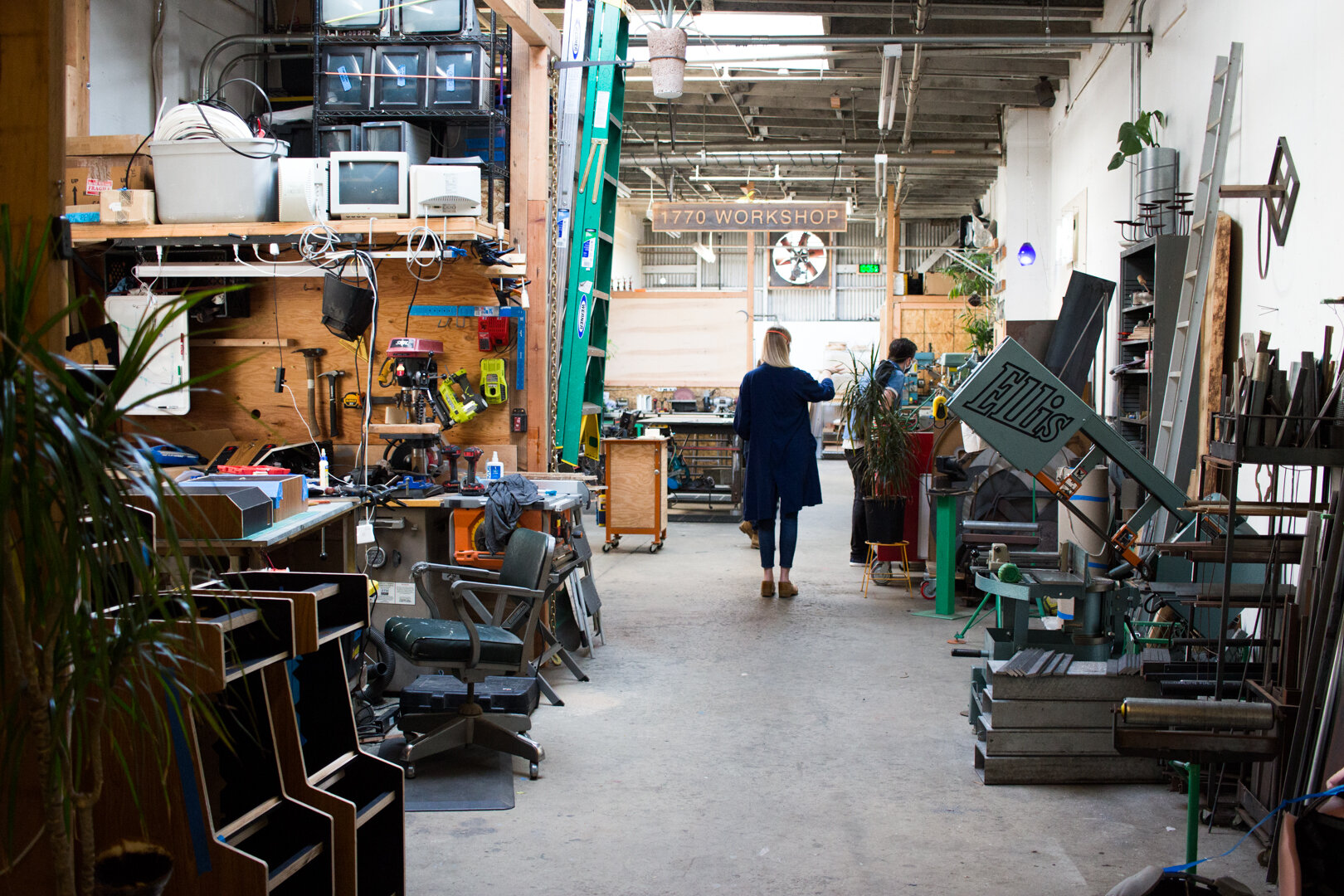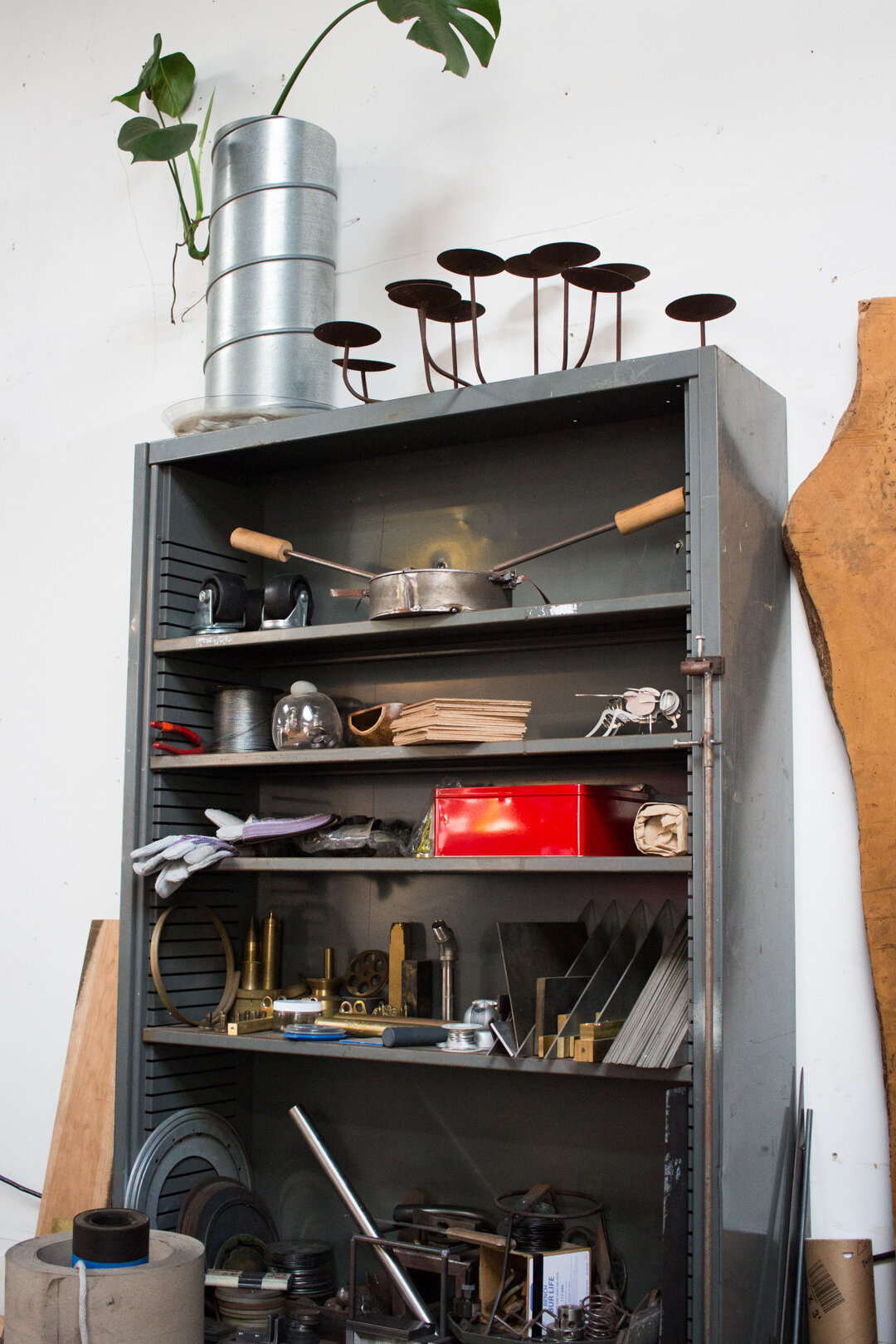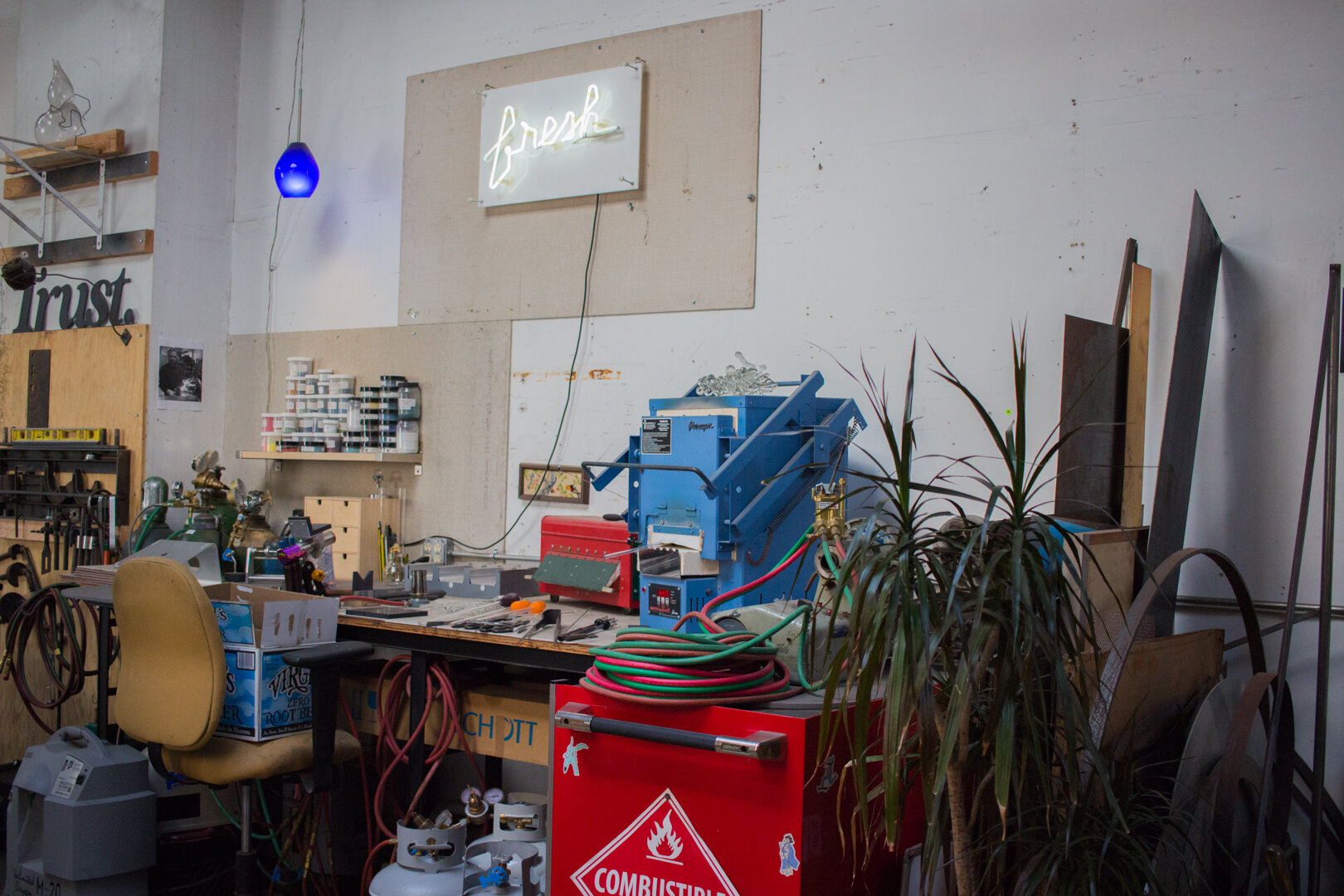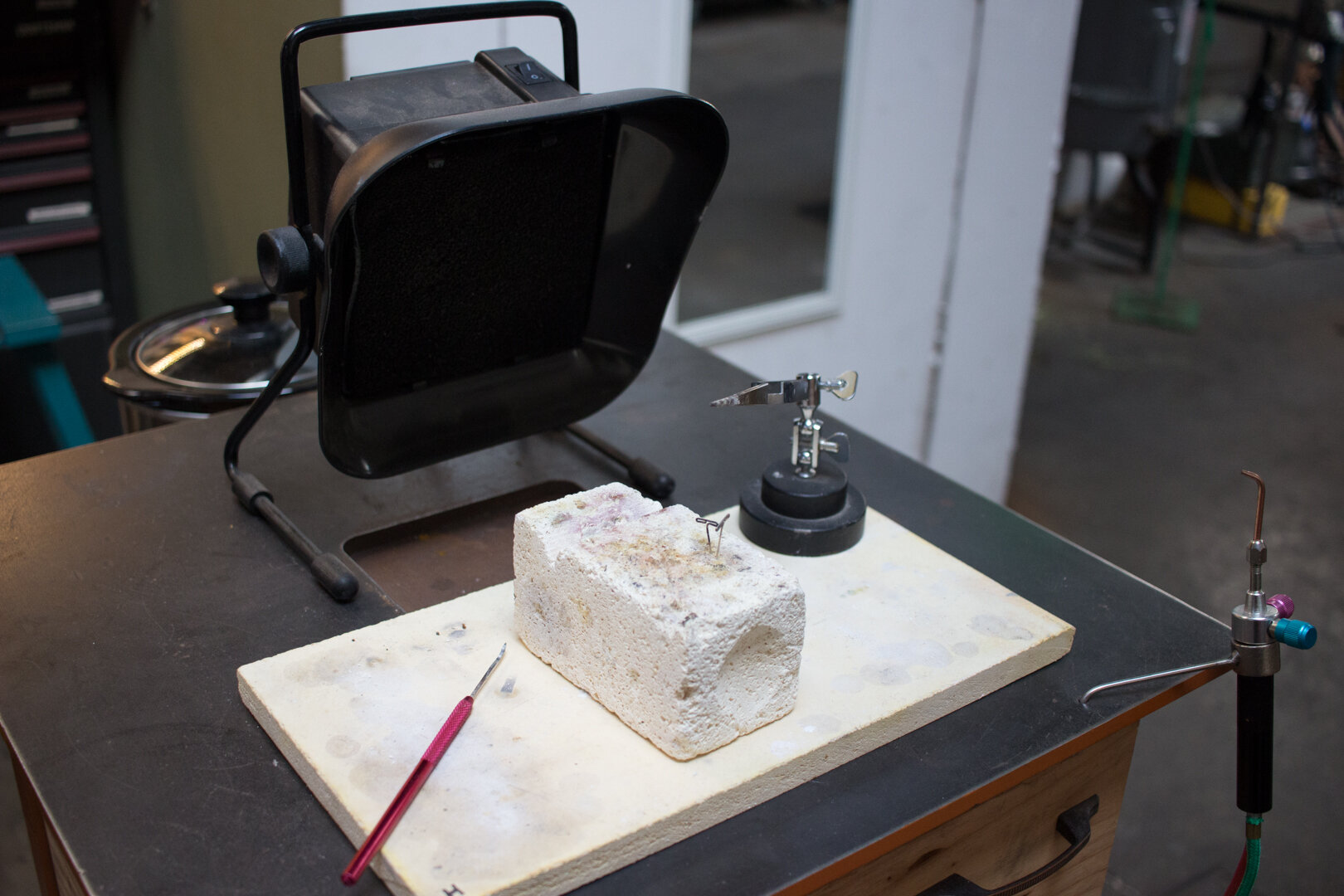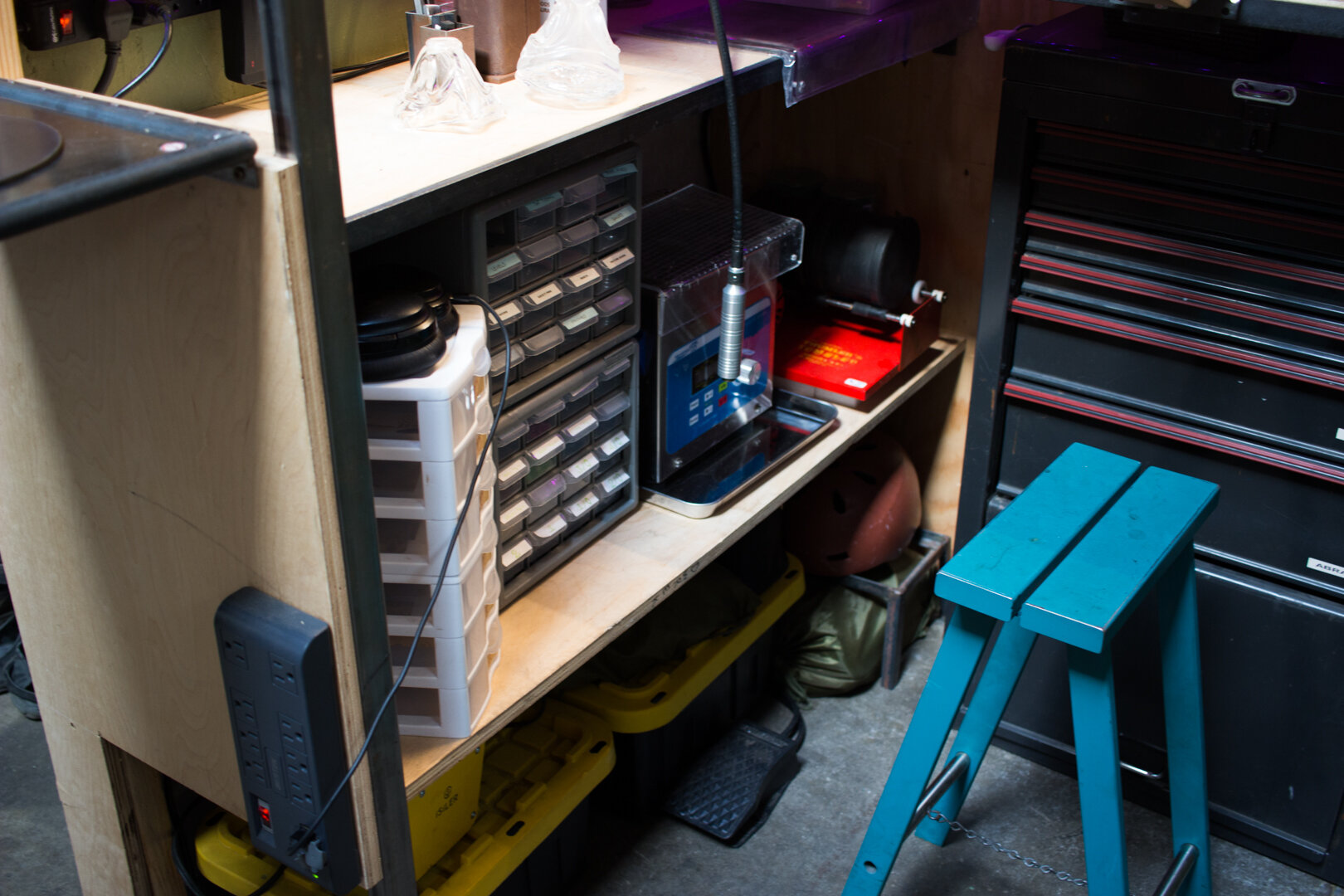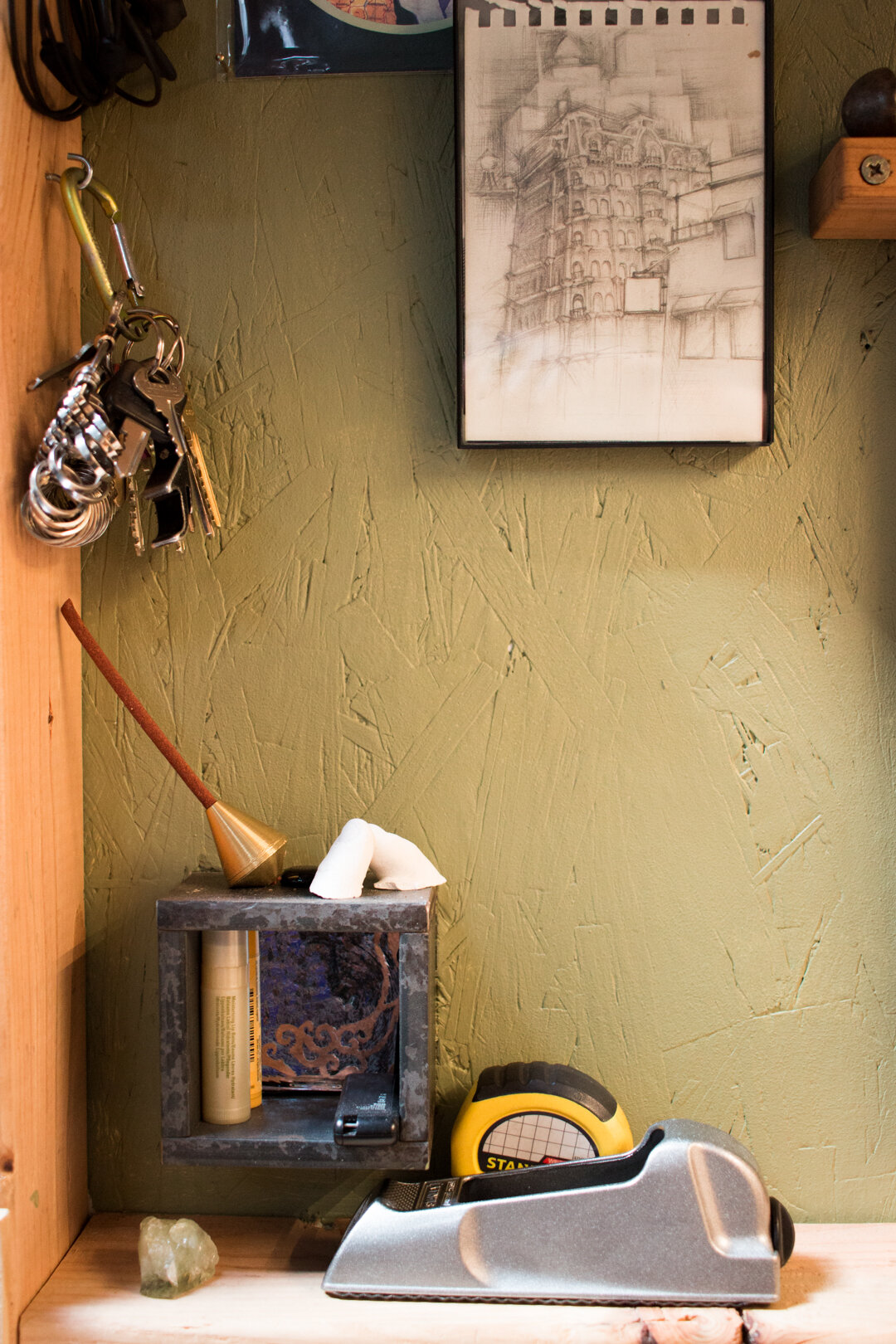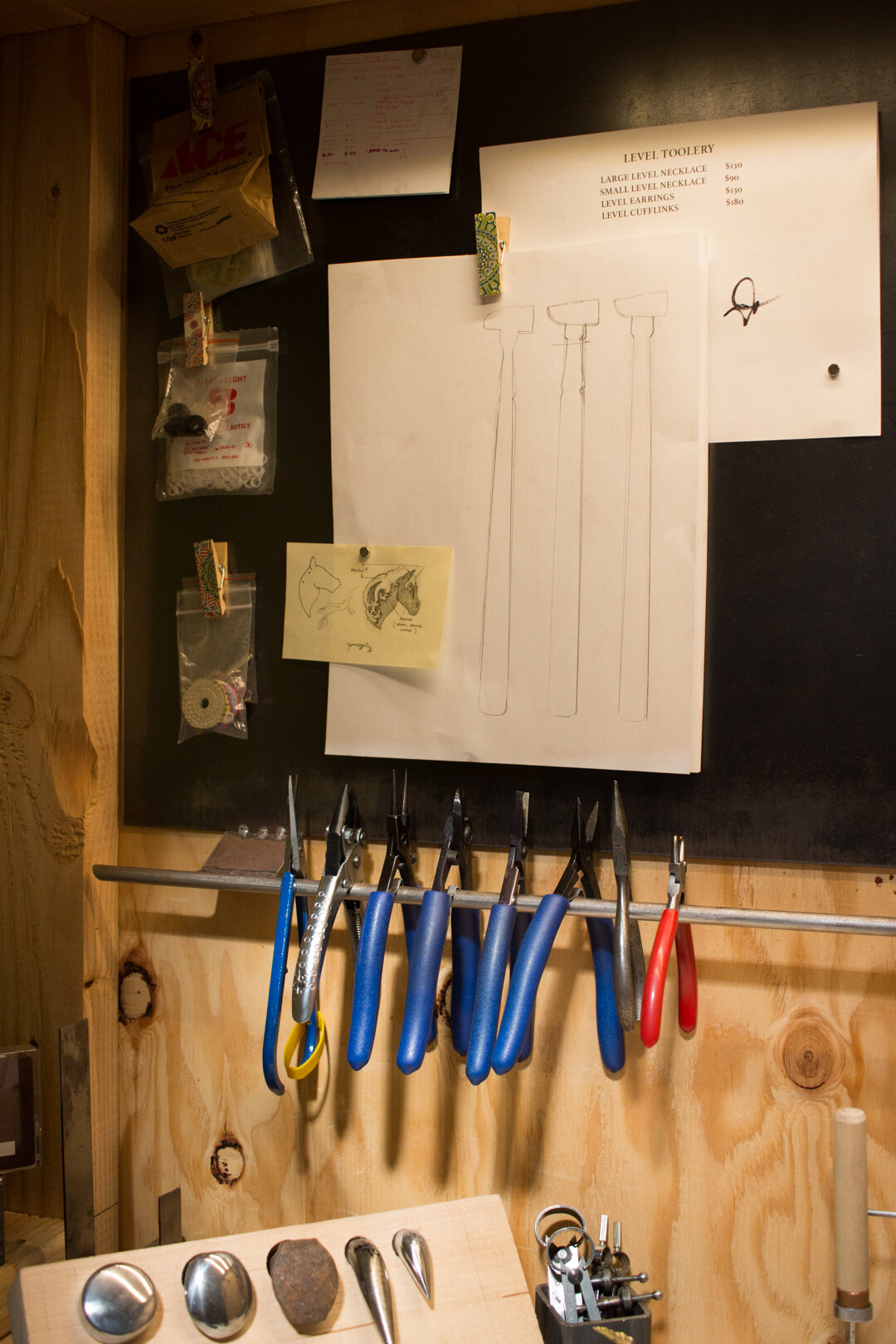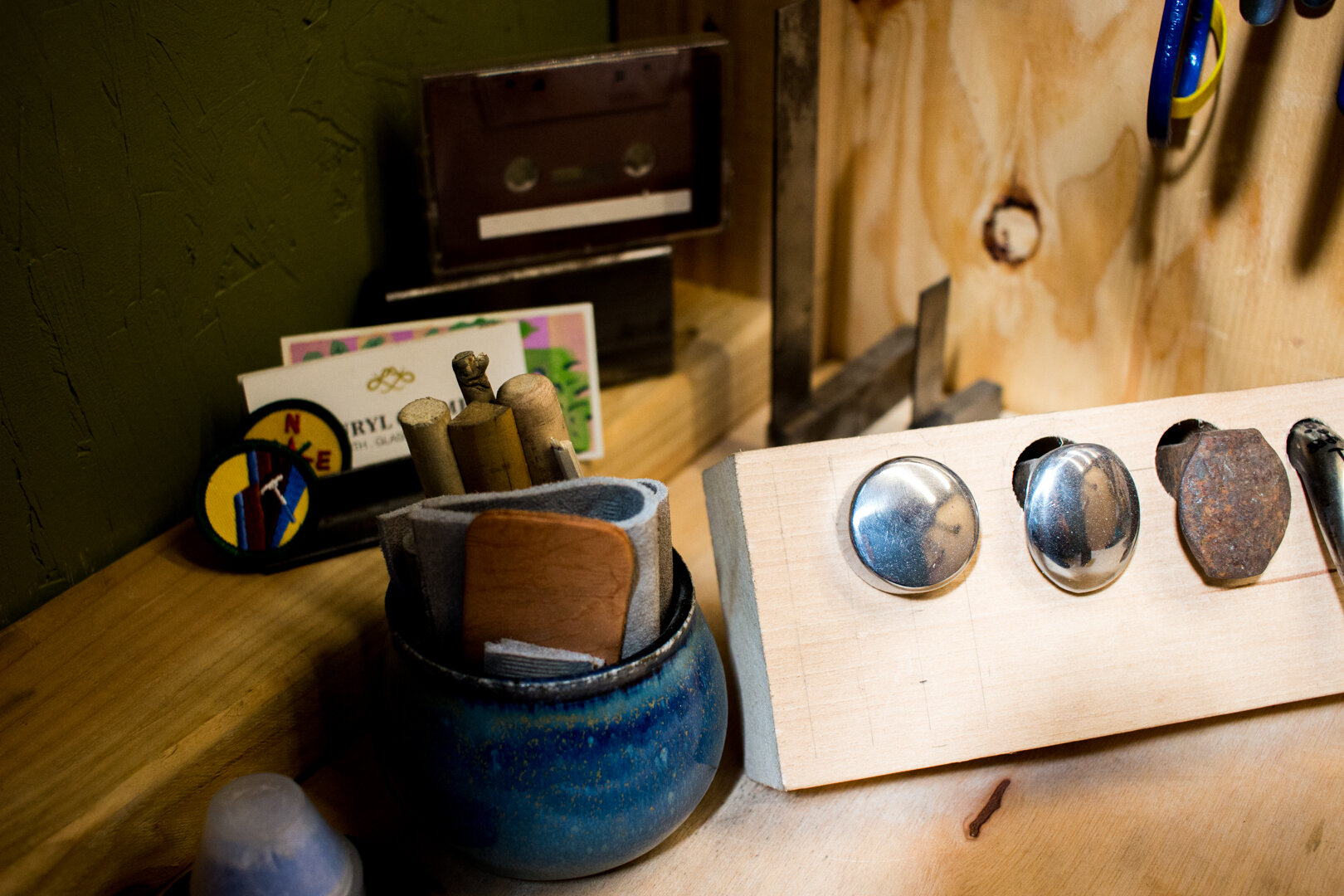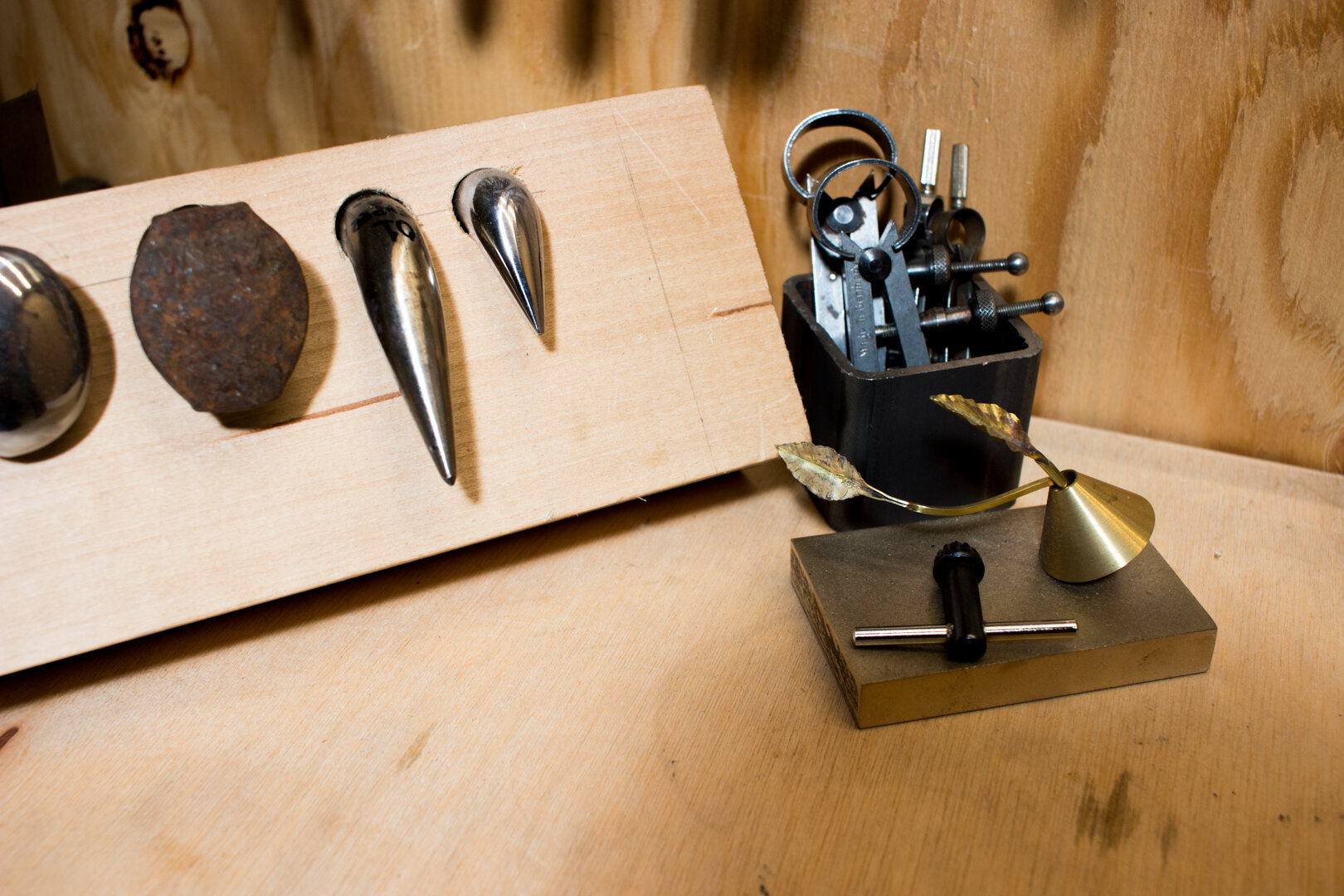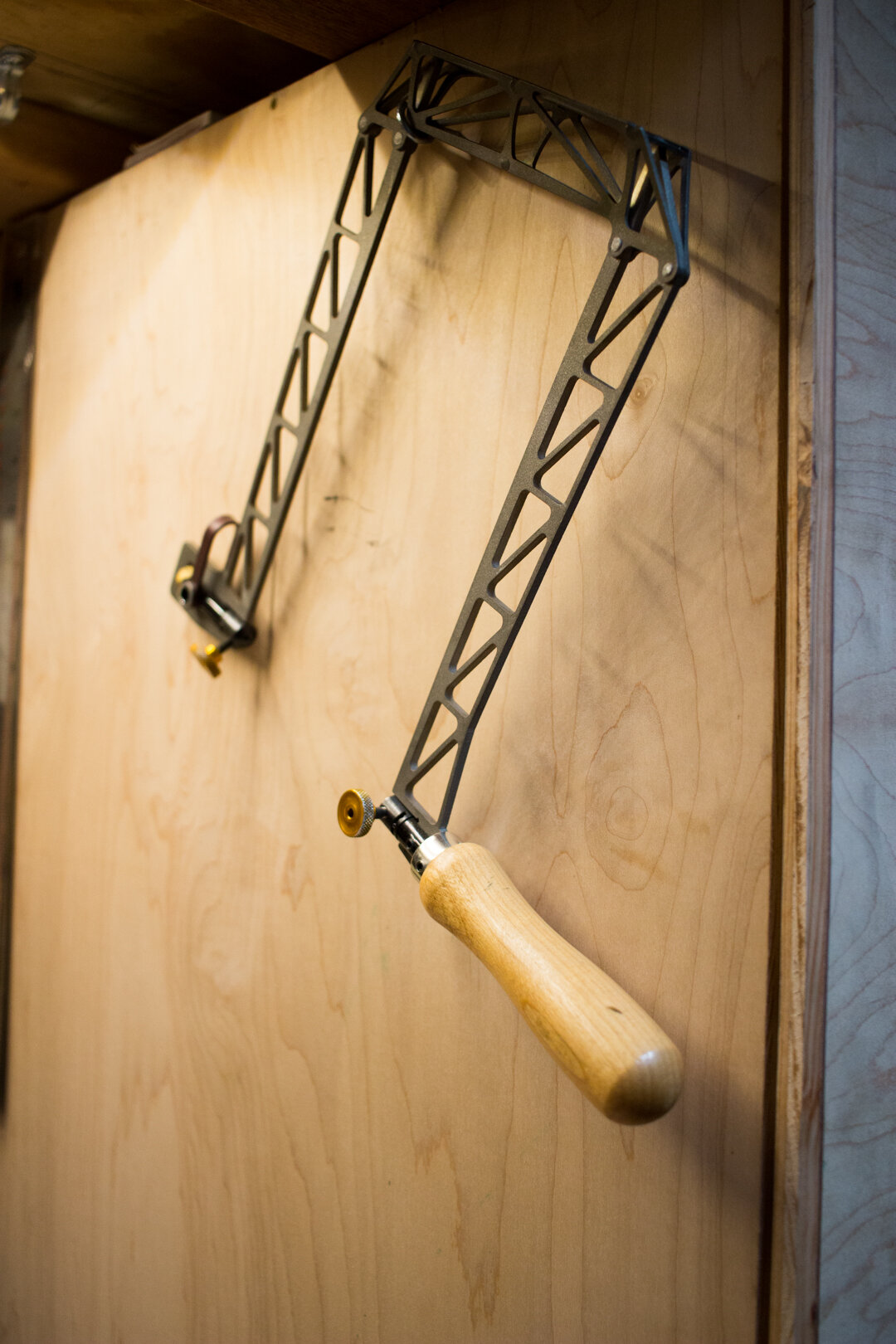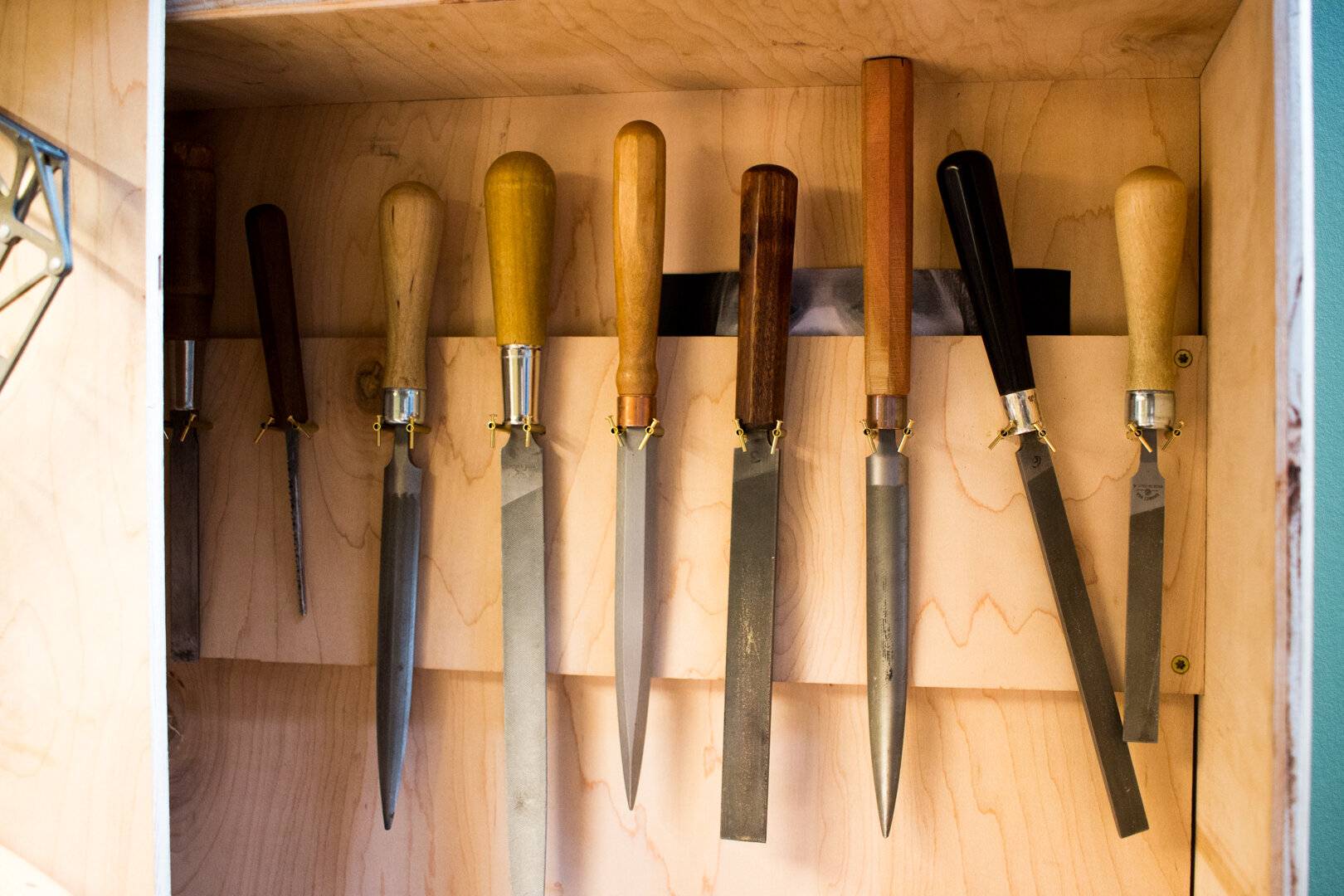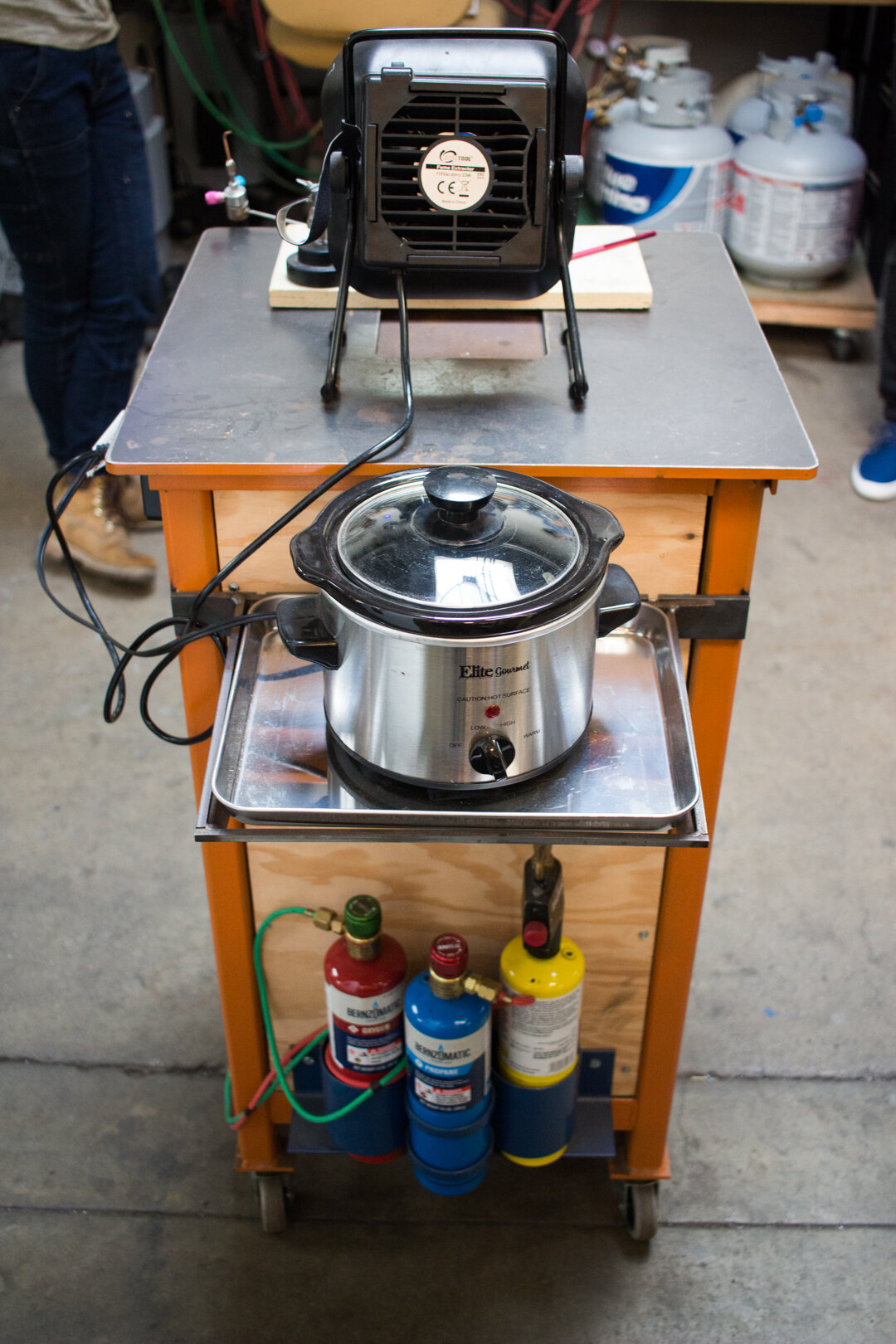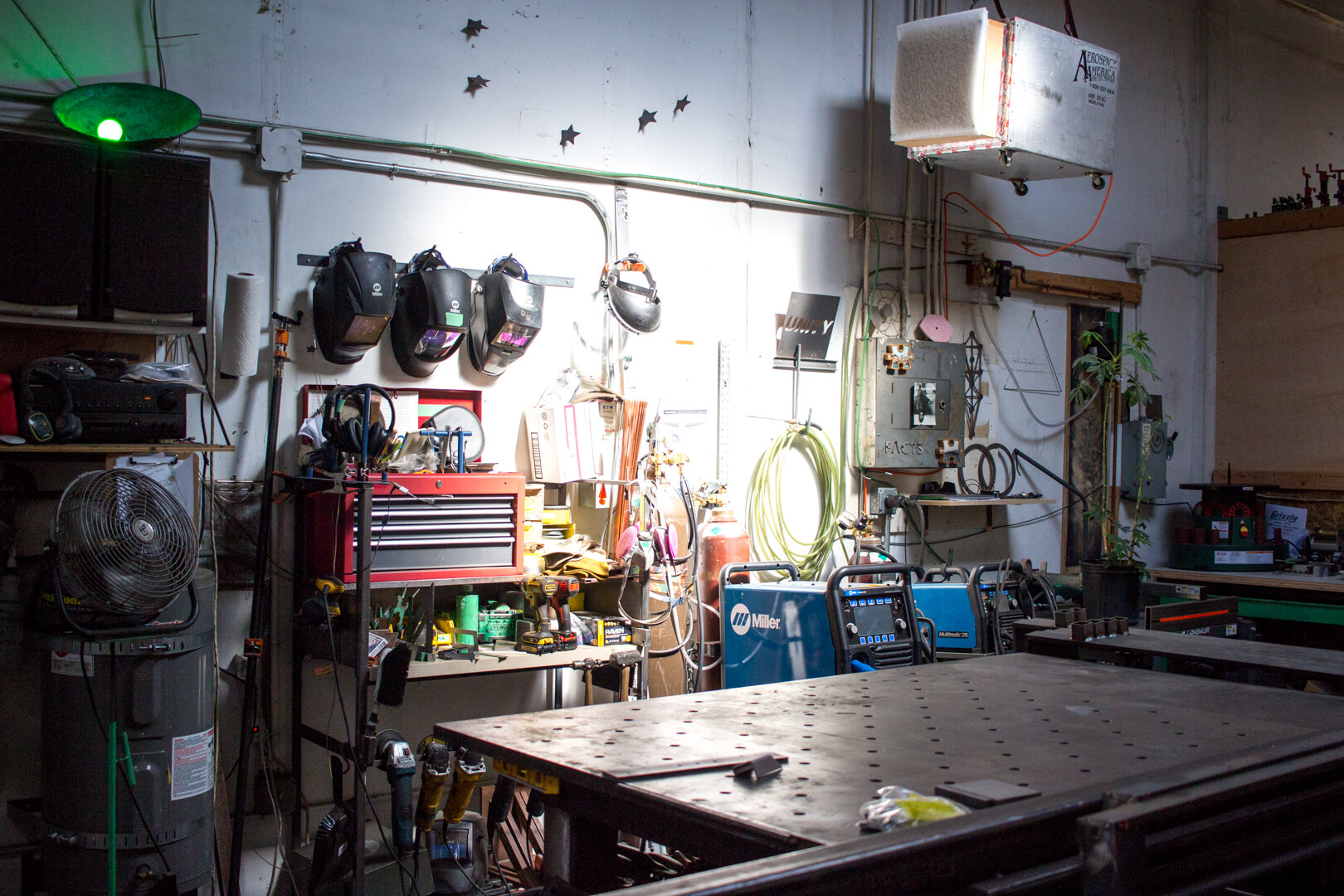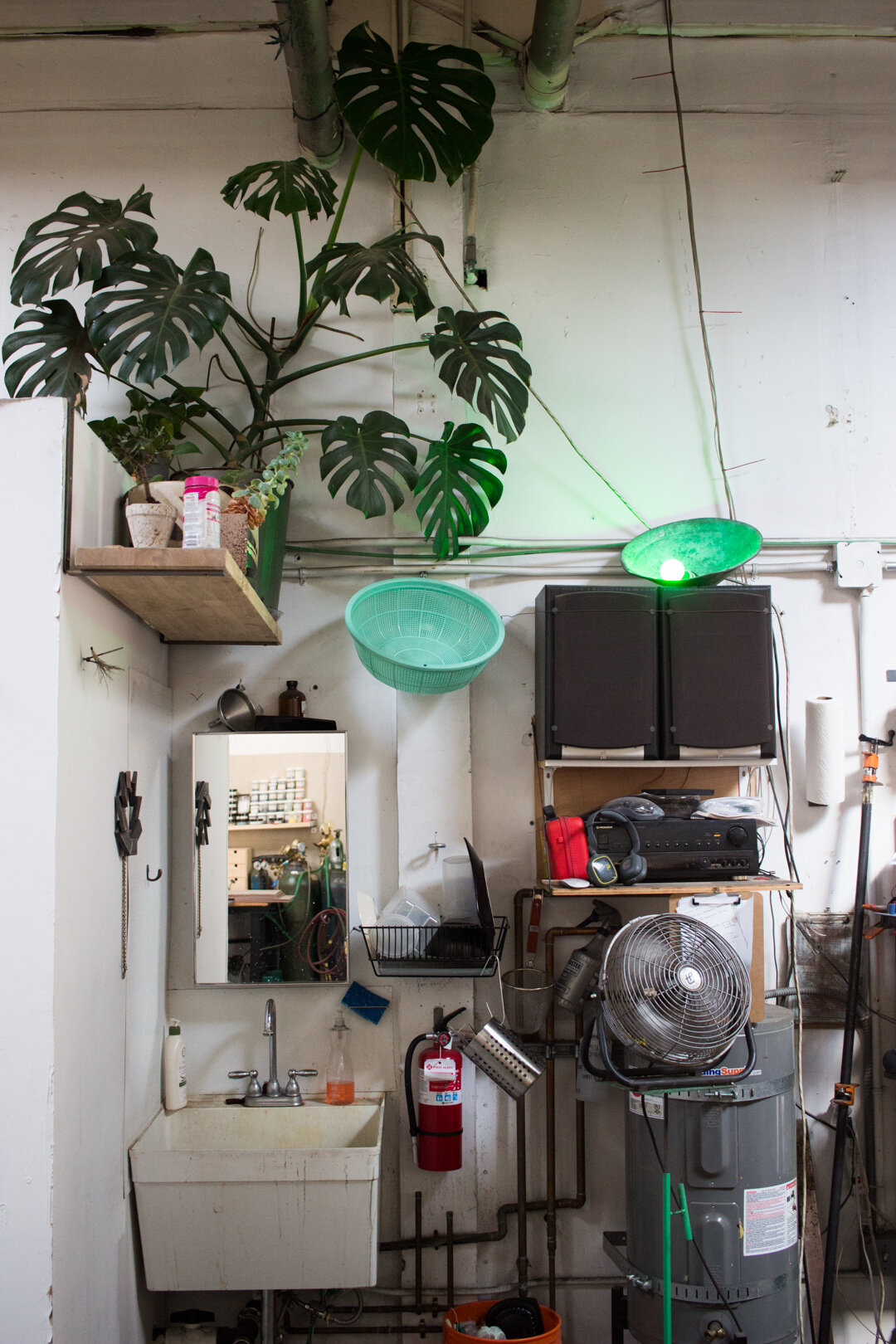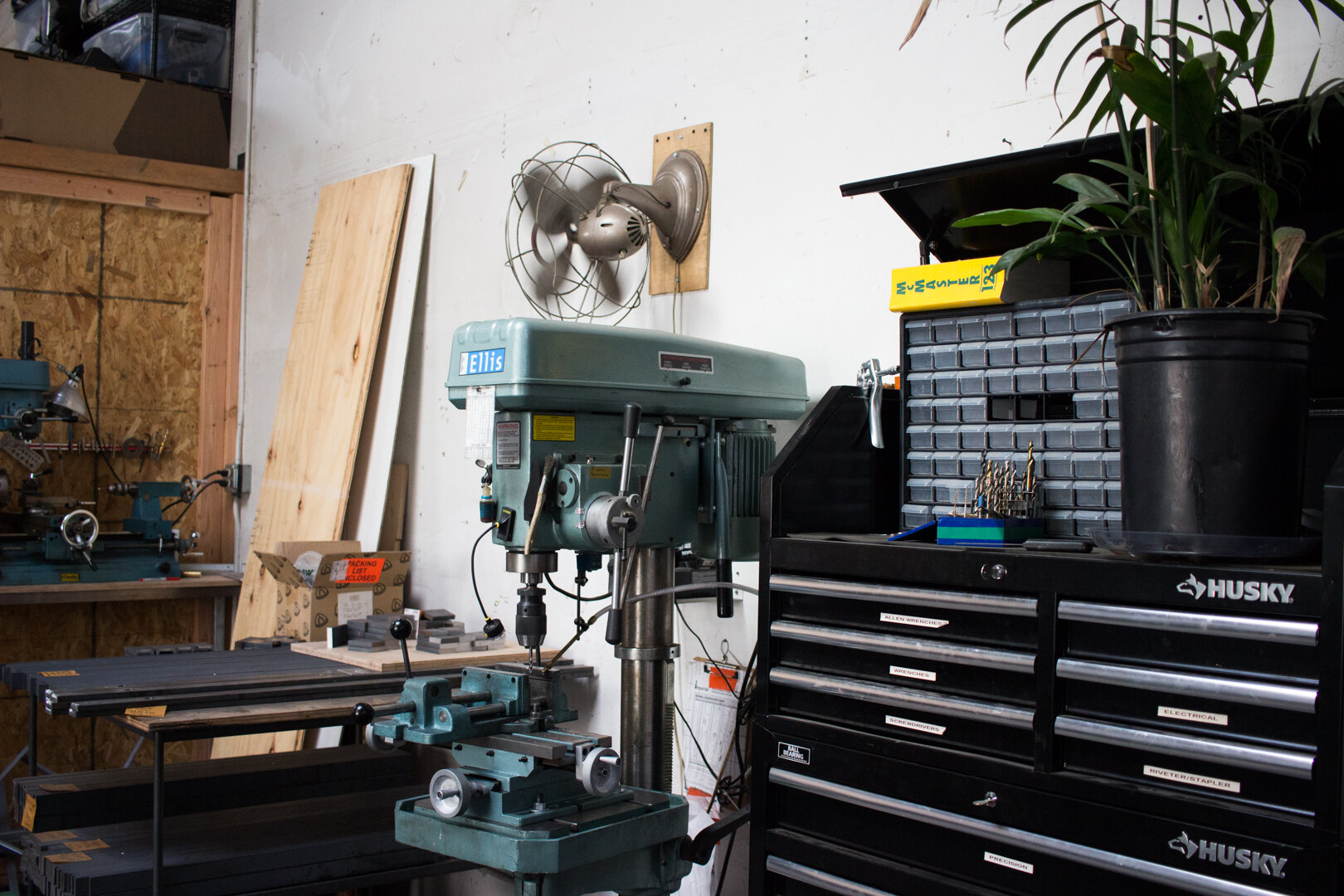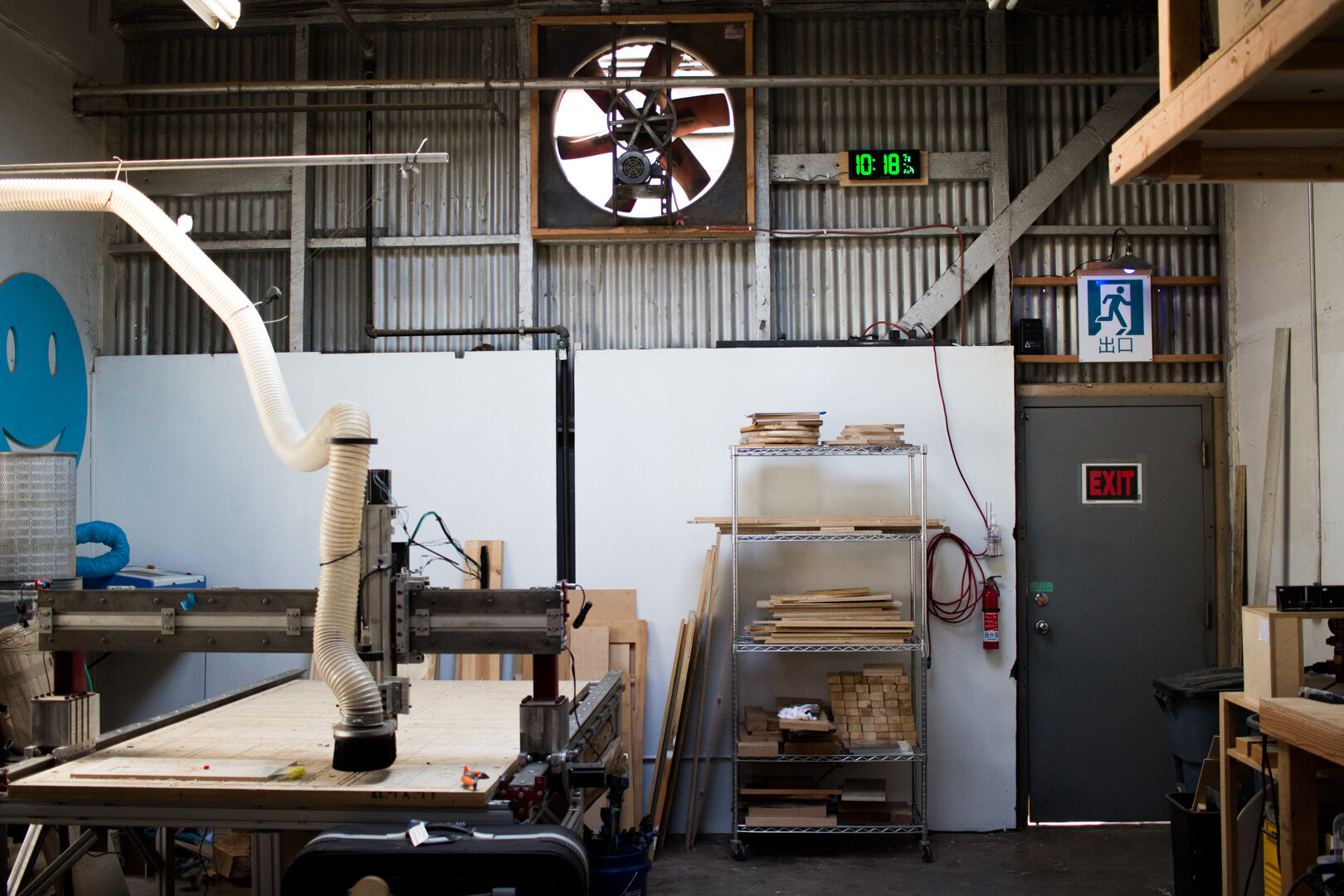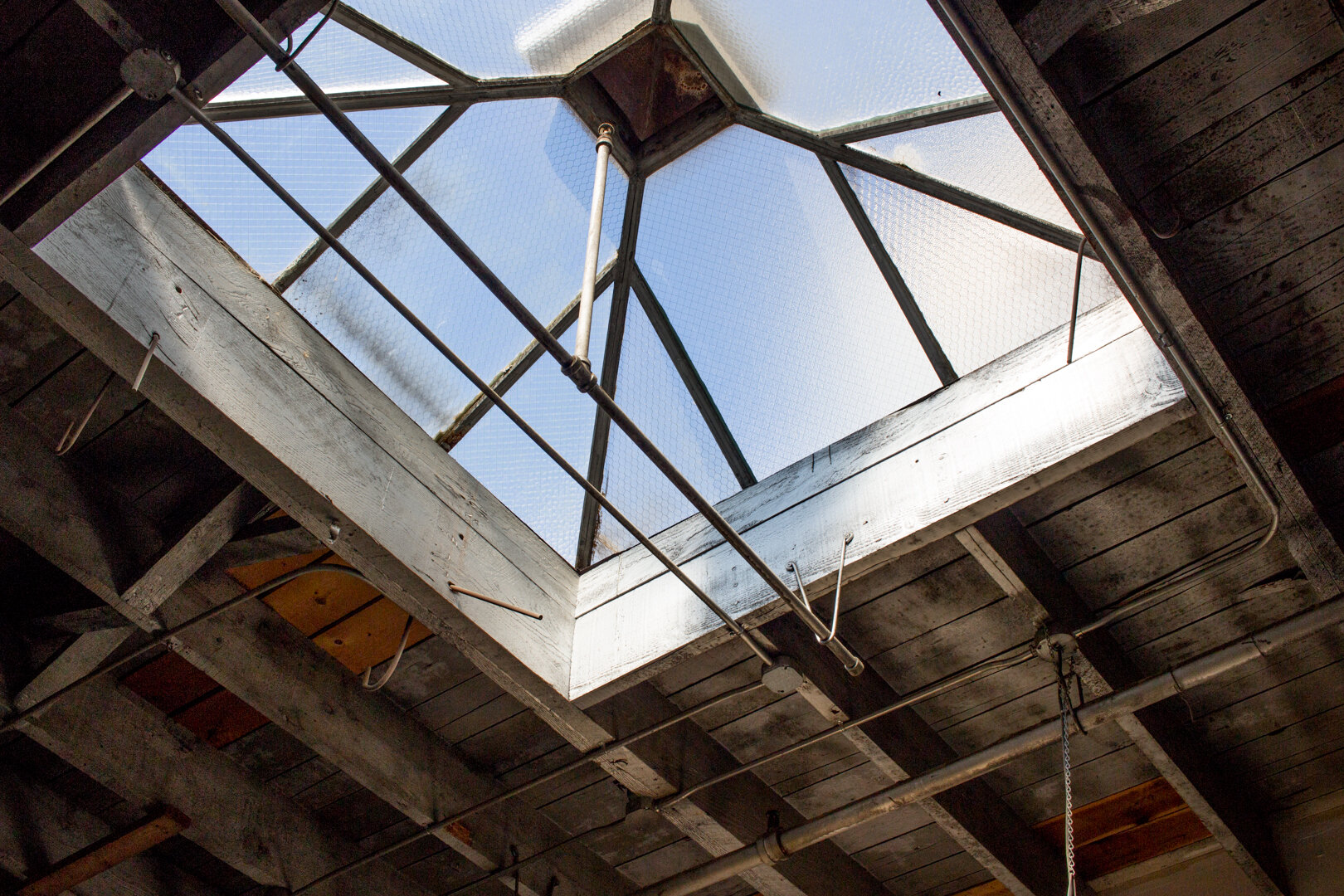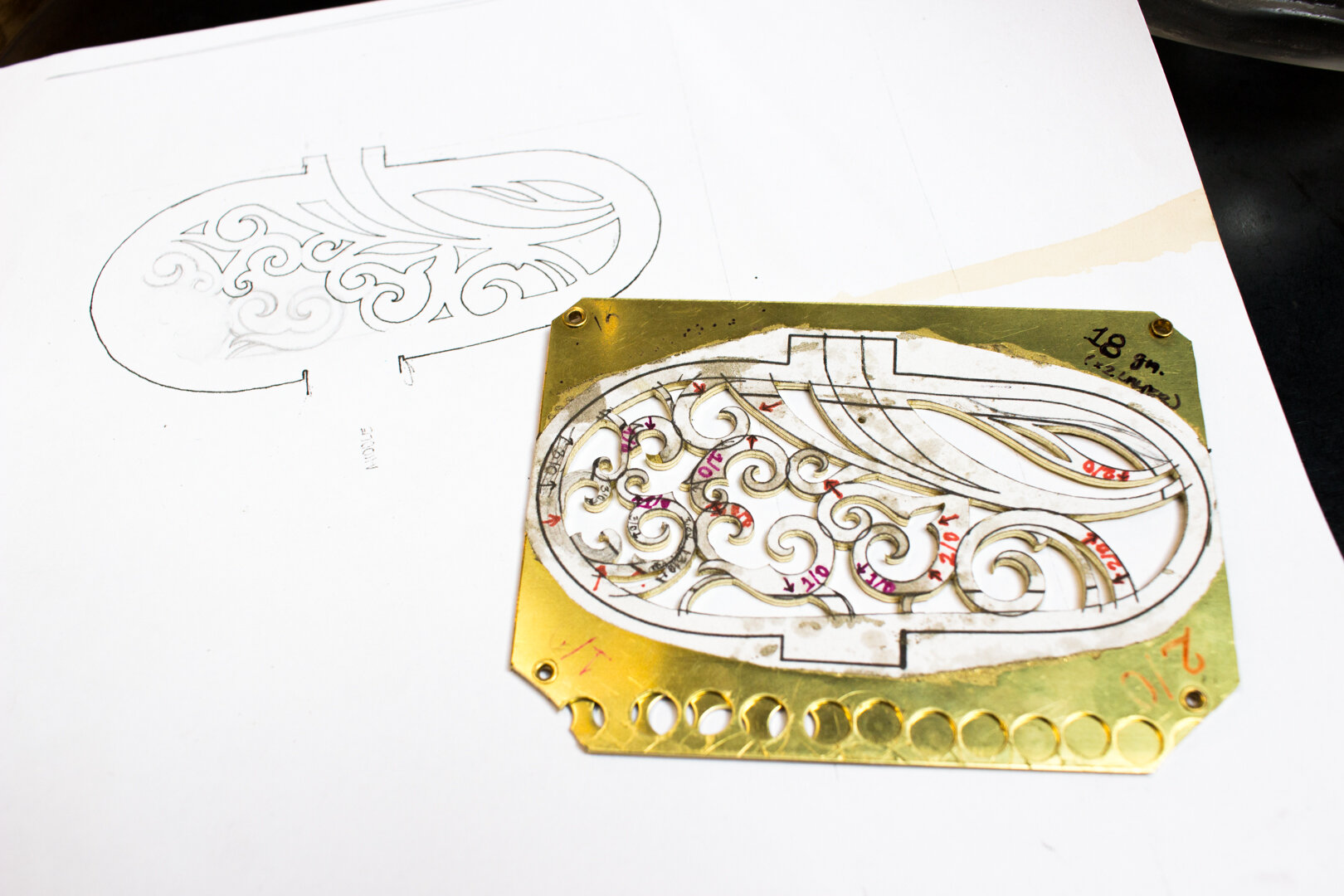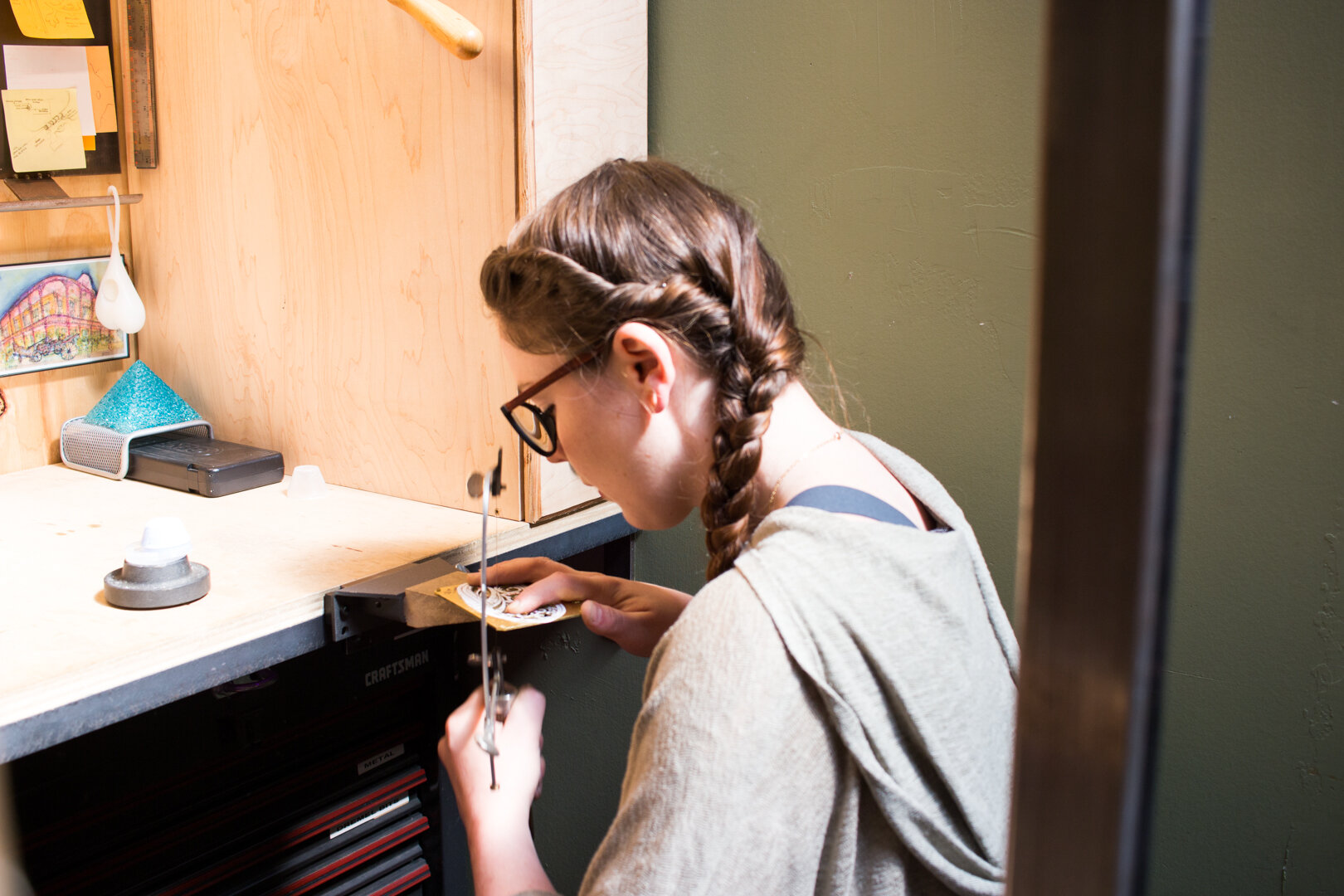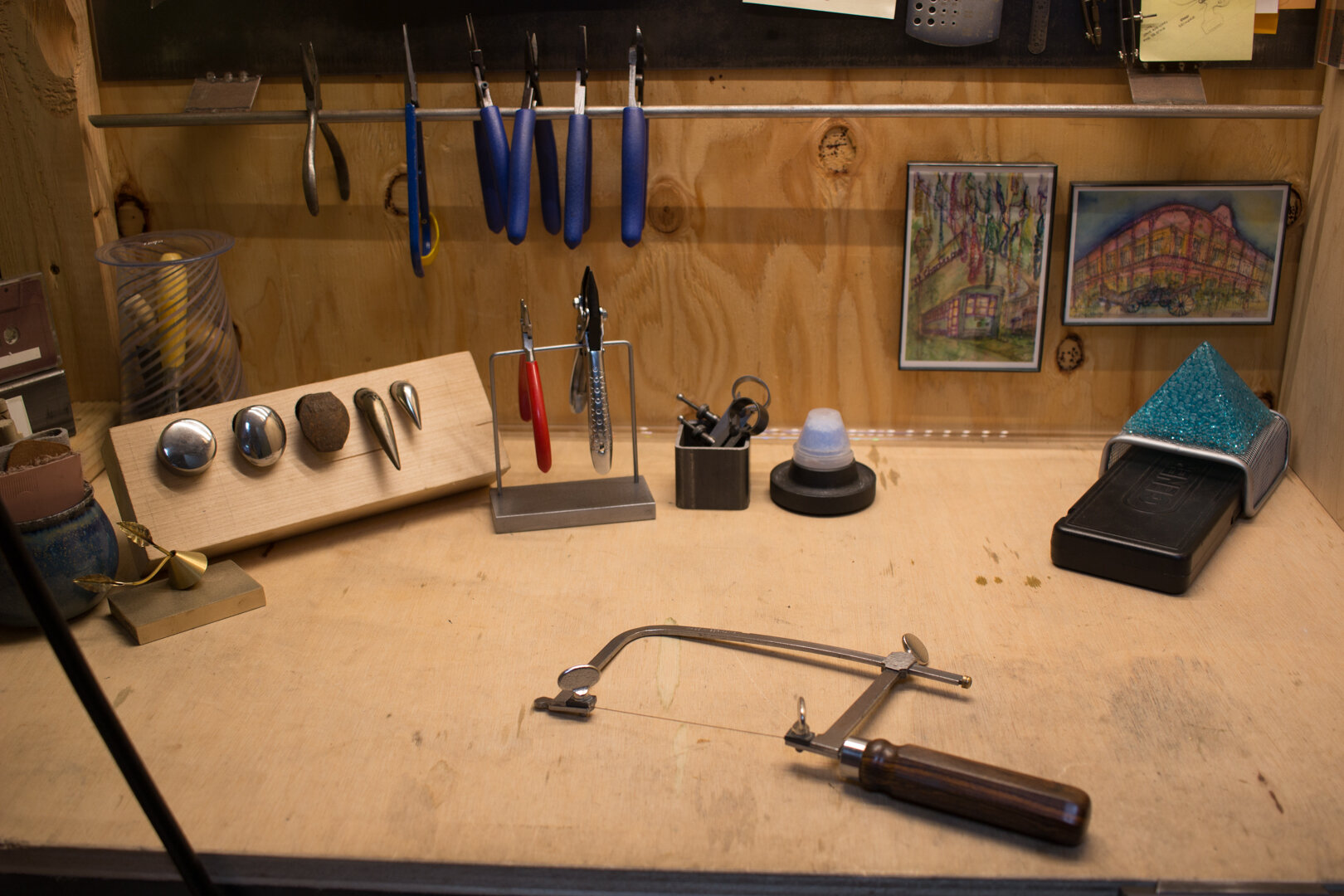I grew up in San Jose, CA with my mom, dad and younger sister. My sister and I, though 5 years apart, were really close and we would work on projects together. Inspiration came from toys we wanted or books we read. I can distinctly remember creating a giant slingshot between two fence posts for launching water balloons and building a cardboard tree for my sister’s rainforest themed bedroom, complete with leaves, branches and door into the secret fort. It was the design of the project and the problem solving involved that I found most entertaining. I still do!
In the Artist’s Studio featuring Lauryl Gaumer is curated by Julie Ericsson.
In the Artist’s Studio featuring Lauryl Gaumer
An artist's workplace can be mysterious, solitary inner sanctum. NUMU's In the Artist's Studio project provides a glimpse into the intimate setting of the creative process.
Lauryl Gaumer creates her art in a pair of workplaces that are one part jewel box—cultivated and fine-tuned to suit her needs—and one part classroom where she can showcase the traditional craftsmanship she has mastered.
Gaumer’s workbench resides within a handbuilt cabinet, fit with cubicles to categorize specialized tools. Rows of miniature drawers enclose precious materials, punches and pliers. A reinforced cart houses her soldering equipment, then efficiently stows away under the workbench when not in use. Rasps and files hang from hooks, while tiny paintings and colorful mementos decorate the ledges around her station, exhibiting Gaumer’s wit and whimsical tastes.
Gaumer takes care to customize some of her instruments too—the tips on a pair of pliers—so that she can make precise adjustments to areas that are difficult to affect with standard tools. Her inclination to the bespoke and attention to detail is present in every piece she fashions.
Both metalsmithing and glassblowing are craft traditions that benefit from millenia of practice. Smithing involves heating metal to shape it—or forging—then fabricating a design. Gaumer combines smithing with bench jeweling to set stones, pierce patterns, and polish metal until it projects luxury. Glassblowing works with different materials, but calls on some of the same principles, replacing a forge with a furnace, and hammering with molds. Gaumer practices and teaches glassblowing at the furnaces of San Francisco non-profit Public Glass. There she has the opportunity for collaboration and knowledge-sharing with other artists, which keeps the craft vibrant and evolving.
IMAGE: Gaumer’s 4ft x 4ft studio space located within a larger shared studio with other artists.
About the Artist
Lauryl Gaumer received her BFA in Spatial Arts from San José State University, and trained in workshops at Haystack Mountain School of Crafts in Maine, Pilchuck Glass School to specialize in metalsmithing and glassblowing, as well as Silvera Jewelry School. She has exhibited work publicly since 2014 including shows such as 2015 Confinement: A Study in Discomfort and Desire, Theta Belcher Gallery, San Jose State University; 2015 Split, Herbert Sanders Gallery, San Jose State University. Her exhibitions in groups shows include 2018 California Open, Tag Gallery, Los Angeles, CA; 2017 Frit: A Glass Exhibition, Social Policy, San Jose, CA; 2017 Art Bra Show, Blue Line Arts, Roseville, CA; 2016 International Student Exhibition, Corning Museum of Glass, Corning, NY; 2015 (Dis)comfort, Piante Gallery, Eureka, CA; 2015 I Wish You Were Here, Martin Luther King Jr. Library, San jose, CA; 2014 International Student Exhibition, Palmer House Hotel, Chicago, IL.
Gaumer’s use of metal and glass—media that contrasts in transparency, rigidity, and traditional function—parallels the thematic discord between the beautiful and the torturous that is evident in her work. Gaumer investigates the docile role and unnatural beauty standards women have been conditioned to inhabit.
Inspired by medieval torture devices, Gaumer’s (Un)Wearable series uses glass and metal to create contemporary devices that decorate while they constrict the body. In the decorative, delicate metalwork and fragile glass forms, Gaumer convinces the viewer of an absurdity in the ideals and devices we allow to shape our bodies and perspectives.
The (Un)Wearables Series
Titles Are Poems
Acknowledging the constriction imposed on a wearer of these devices, Gaumer chooses media that delicately and dangerously coax their wearer into evocative postures. In her choice of titles, we glimpse at Gaumer’s vision of the persona who inhabits her work. She crafts phrases that tie the gleaming polished materials and ornate designs to sensations of longing and desire.
“I consider the titles of my work to be an opportunity to make each piece more personal. The titles are intended to be a snippet of story or a piece of poetry, which offers a glimpse into the life of an individual. With the sense of choice or conflict in my titles, I try and touch on the fact that each individual has depth and struggle.”
Interview with the Artist
I have been a receptionist, bartender, and organizer. I have also taught jewelry and glassblowing.
When I felt like I started to make work that meant something to me and could be meaningful for others as well. As a student at San Jose State University, I came to realize how I was, was not in alignment with how I wanted to be. The subsequent (Un)Wearable series speaks to the complexity of the female experience. My work is an opportunity for me to process my thoughts and consider interactions with those around me.
My studio is my home. I ornament it with pieces that inspire me, either because of my interest in the object or because of the person or event that brought that object into my life. Alongside my curiosity collections are my tools, materials and references. A majority of my metalwork is done within the 4ft. Boundaries of my studio. I fabricate most of my work with sheet metal and manufactured metal rod and tubing, using a jewelry saw for precise cuts and files and sandpaper to refine. Lots of sandpaper. Before using the jewelry saw, I draw the component without the scroll pattern with a fine pen and scan the schematic. I am then able to sketch multiple iterations of my scroll pattern within the boundaries of the drawn component. This is the extent of my technological capabilities. Once I am happy with the pattern, I spray adhere the image to my sheet metal and get to work. To get perfectly mirrored pieces, I rivet layers of sheet metal together before drilling my starter holes and sawing the pattern with my jeweler’s saw.
Coffee! I try to give myself the time to clear off my desk and sweep before beginning to work. If I skip cleaning at the beginning of the day, I find myself distracted by the clutter and end up breaking my creative flow to consolidate and put away. Luckily, my desk is small so it doesnt take long.
When I’m beginning a new piece, I begin by researching historical devices, torturous or otherwise. The historical nature of an artifact often is my source of inspiration. I then will often choose a process I wish to practice and start to design a piece with that skill set in mind. For the collar from the Heretic Fork, I wanted to focus on turning points on a lathe. For the respirator, I wanted to practice the art of the hinge.
The inherent properties of the material.
Glassblowing is inherently captivating, with the fluid movement of the glass and glow of the fires. Glass is also interesting in its material properties. For me, I find an honesty in that transparency, additionally the fragility of the glass adds to the concepts I am working with. The body has been decorated for thousands of years and I use metalwork to continue that tradition. In my process, I have found a need to create and alter tools to achieve a desired result so toolmaking is a new hobby of mine. Because of that, woodworking is something I want to become more familiar with. Beyond that, there are other mediums I would love to incorporate into my work like textiles for example, but that is where I would actually prefer to collaborate with another individual.
I think about conceptual art and these pieces that stand squarely in concept and lack or ignore visual intrigue. I want the themes of my work to resonate, even while the intricacies of the work holds the attention of the viewer.
Technique and craft mean so much to me. The problem solving necessary to complete a piece without glue is an aspect of creation I enjoy most. In avoiding the use of glue, I plan cold connections like rivets or hinges into my designs to puzzle components together. This process contributes to my aesthetic and gives the viewer the opportunity to dissect each piece and discover how it was made.
Maybe collar #2, titled, She held her head high, unable to let her chin fall, as that piece represents the conflicting ideas I work to bring together. It is an idea I plan to work with more as a study of pointed collars.
- “It actually is more comfortable now that it’s on, as long as I relax into it”
- “It hurts to look at”
- “It reminds me of armor”
- "You must be kinky"
When the deadline has come. Even after a piece is quote on quote finished, I find myself reconsidering the display or have been known to add more details to the work.
That is such a good question, and I find I am drawn to evolution. Although I am interested in referring to and using historical techniques in my work, I work with the processes in new ways while drawing from my own experiences.
It is never too late to readdress an issue. Don’t leave for tomorrow what you can do today. Reading is never a waste of time.
I now work in a predominately white male industry. In college, I watched myself, silence in instances of sexual harassment and lacking immediate response to emotional abuse and rape left me feeling ashamed. I felt trapped in my female body, unable or unwilling to push back against instances of discomfort. This led to my first collar, inspired by the Scold’s Bridal, a medieval torture device that cages the face and, in many designs, makes speech and eating impossible.
The artist is an educator. Art has the ability to reshape perspective and educate. Each artist finds an aspect of existence they are compelled to explore and their role is to share the truths discovered.
In The Artist’s Studio featuring Lauryl Gaumer is made possible by the generous support of The Borgenicht Foundation. The Borgenicht Foundation supports social justice, conservation and historic preservation, the arts, health, and education.
